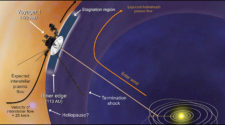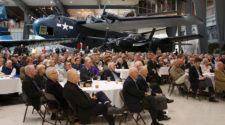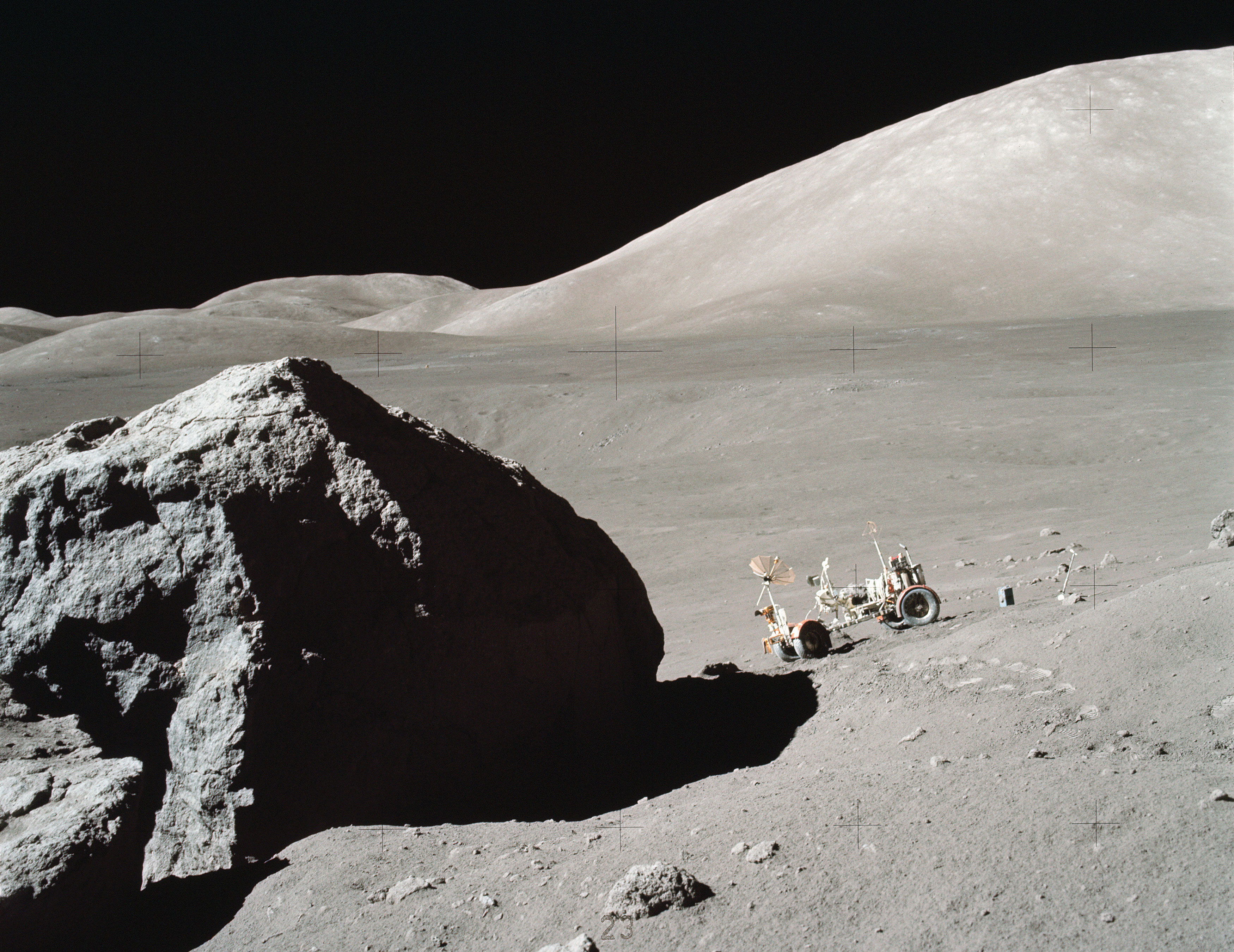
Forty years ago, humanity left its last footprints on the surface of another celestial body. Apollo 17 astronauts Gene Cernan and Harrison ‘Jack’ Schmitt guided their lunar module Challenger down into a beautiful, mountain-ringed valley in the Taurus Mountains, on the edge of the Moon’s Serenitatis basin, just south of the ancient crater Littrow.
The spectacular landing site had been selected in February 1972, having been extensively photographed from orbit during the Apollo 15 mission. When they visited ‘Taurus-Littrow’, Cernan and Schmitt achieved the exalted goal of setting foot on an alien world…and left a gaggle of disappointed fellow astronauts back on Earth.
Chapter One: Picking the Men
To understand the crew-selection process in that long-gone era, the central character was Deke Slayton, an astronaut himself and since the early 1960s served as NASA’s head of Flight Crew Operations. In the early Apollo period, he developed a three-flight rotation system, whereby the astronauts on the backup team of a given mission would fly as the prime crew three missions later. Hence, the Apollo 9 backup crew of Pete Conrad, Dick Gordon and Al Bean were recycled as the Apollo 12 prime crew.
It would make sense to suppose that the Apollo 14 backup crew – Gene Cernan, Ron Evans and Joe Engle – would thus have been in pole position to take the Apollo 17 seats. Had NASA not been required by Congress to cancel its last two Apollo landing missions, it is quite possible that this is what would have happened.
But there was a problem. On the Apollo 15 backup crew – and therefore probably pointed toward the Apollo 18 prime crew – was NASA’s only professional geologist-astronaut, Dr. Schmitt, and the space agency had long been under intense pressure from the National Academy of Sciences to fly him to the Moon.
Since his selection by NASA in 1965, Schmitt had worked extensively on Apollo, covering the lunar surface experiments packages, the lunar module descent stage systems and other elements of cargo and tools. He single-handedly came up with a lunar-orbit science plan for Bill Anders to follow on Apollo 8 and was closely involved in the geological training of subsequent landing crews. It paid off.
In March 1970, Schmitt’s name was formally announced on the Apollo 15 backup crew. Joining him would be Dick Gordon as his commander (and lunar-landing buddy) and command module pilot Vance Brand.
For the scientific community, it was a moment of triumph. Many had pushed for a geologist to be aboard the first lunar landing mission, although the engineering demands of that flight made it relatively easy for NASA to snub them. However, as successive Apollo crews – all military pilots – journeyed to the Moon, it became harder and harder for the space agency to explain away their decision not to include Schmitt.
When Apollo 18 was cancelled, the men who would have served as its crew were deeply disappointed, but Gordon felt that with Schmitt on his team there was a very good chance that Deke Slayton might overlook the rotation system and assign them to Apollo 17 instead.
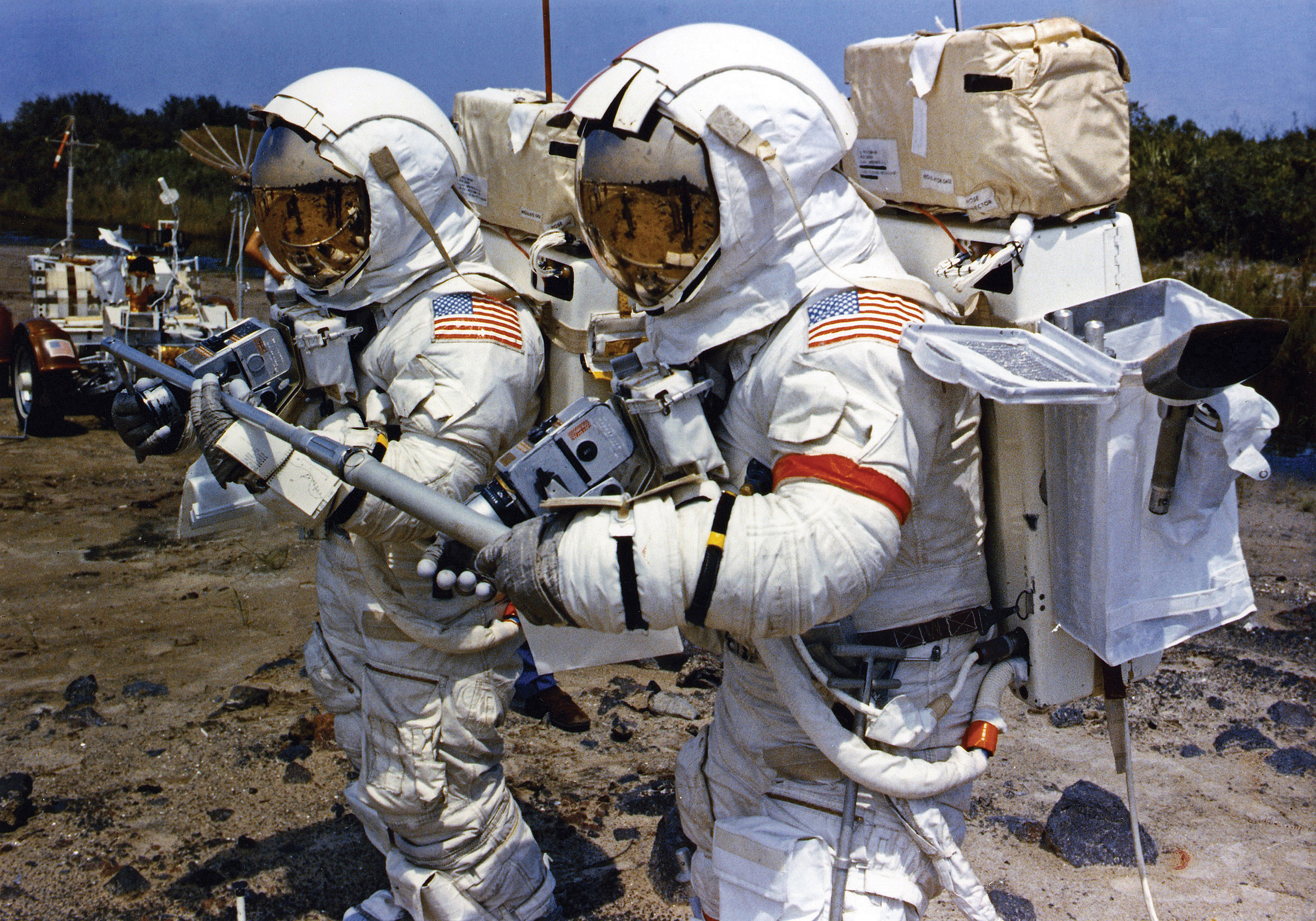
Then, on 23 January 1971, an incident in Florida’ Banana River seemed to improve the chances of Gordon’s crew significantly.
On that day, Cernan, in his role as Apollo 14 backup commander, was flying a tiny Bell H-13 Sioux helicopter – a type which became famous in M*A*S*H – on a training mission. The chopper was routinely employed by Apollo commanders as a tool for lunar landings.
Cernan flew down the Atlantic side of Cocoa Beach, over Melbourne and back up the Indian River towards the Cape. Mischievously, he decided to ‘flat-hat’ the river, but as he looked at the reflective bottom his eyes lost touch with the water. One of the helicopter’s skids touched the calm surface of the river and the H-13 crashed in a spectacular explosion.
“Spinning rotor blades shredded the water, then ripped apart and cartwheeled away in jagged fragments,” Cernan wrote in his memoir, The Last Man on the Moon. “The big transmission behind me tore free and bounced like a steel ball for a hundred yards before going down. The lattice-like tail boom broke off and skittered away in ever-smaller pieces, the plexiglas canopy surrounding me disintegrated, one of the gas tanks blew up and what remaining of the demolished chopper, with me strapped inside, sank like a rock.”
Miraculously, Cernan survived and swam to safety through water coated with burning fuel. Boaters hurried to his aid. After being patched up at Patrick Air Force Base, Cernan – his eyebrows singed and his backside charbroiled – strode into the crew quarters to see an astonished Al Shepard, commander of the Apollo 14 prime crew, having breakfast.
In true ‘Right Stuff’ fashion, Cernan told Shepard that things were so boring at the Cape, he had to do something to get some publicity for Apollo 14!
“Right!” Shepard grinned.
Deke Slayton, though, was in no mood for humour. At first, he tried to give Cernan an easy way out before talking to the press – offering to tell them that the helicopter itself was to blame, that its engine had failed. No, Cernan told him, “it didn’t fail. I just screwed up.”
When the investigation board, chaired by astronaut Jim Lovell, published its report on the accident in October 1971, it concluded that “misjudgement in estimating altitude…[was] the primary cause”. In admitting blame and telling the truth, Cernan knew that he may have screwed his chances of someday commanding Apollo 17, but was aware that honesty went a long way with Deke Slayton.
On 13 August 1971, NASA formally announced the prime Apollo 17 crew. Slayton was unprepared to break up ‘core’ Apollo 14 backup crew of Cernan and Evans…but bowed to pressure and added Schmitt as the mission’s lunar module pilot.
That spelled particularly bad news for Dick Gordon and Vance Brand, obviously, but perhaps the person who suffered the most was Cernan’s original lunar module pilot, Joe Engle. Writing two decades later, in his landmark book A Man on the Moon, Andrew Chaikin noted that Engle’s toughest challenge in those bitter days was explaining to his children that he was not going to the Moon.
This does not imply that Slayton had no confidence in Engle; quite the opposite, for Engle was a former X-15 pilot, with three flights above 50 miles, and would later earn renown as the only astronaut to fly the Shuttle wholly manually from the de-orbit through the atmosphere to touchdown.
Cernan described him as “a magnificent aviator”, but admitted that Engle was not as knowledgeable about the lunar module’s quirky systems as he would have liked. To Cernan, it mattered little, for his experience from Apollo 10 imbued him with the skills to carry both of them, and Slayton retained sufficient confidence to recommend the names of Cernan, Evans and Engle to NASA Headquarters as the Apollo 17 prime crew.
It was rejected.
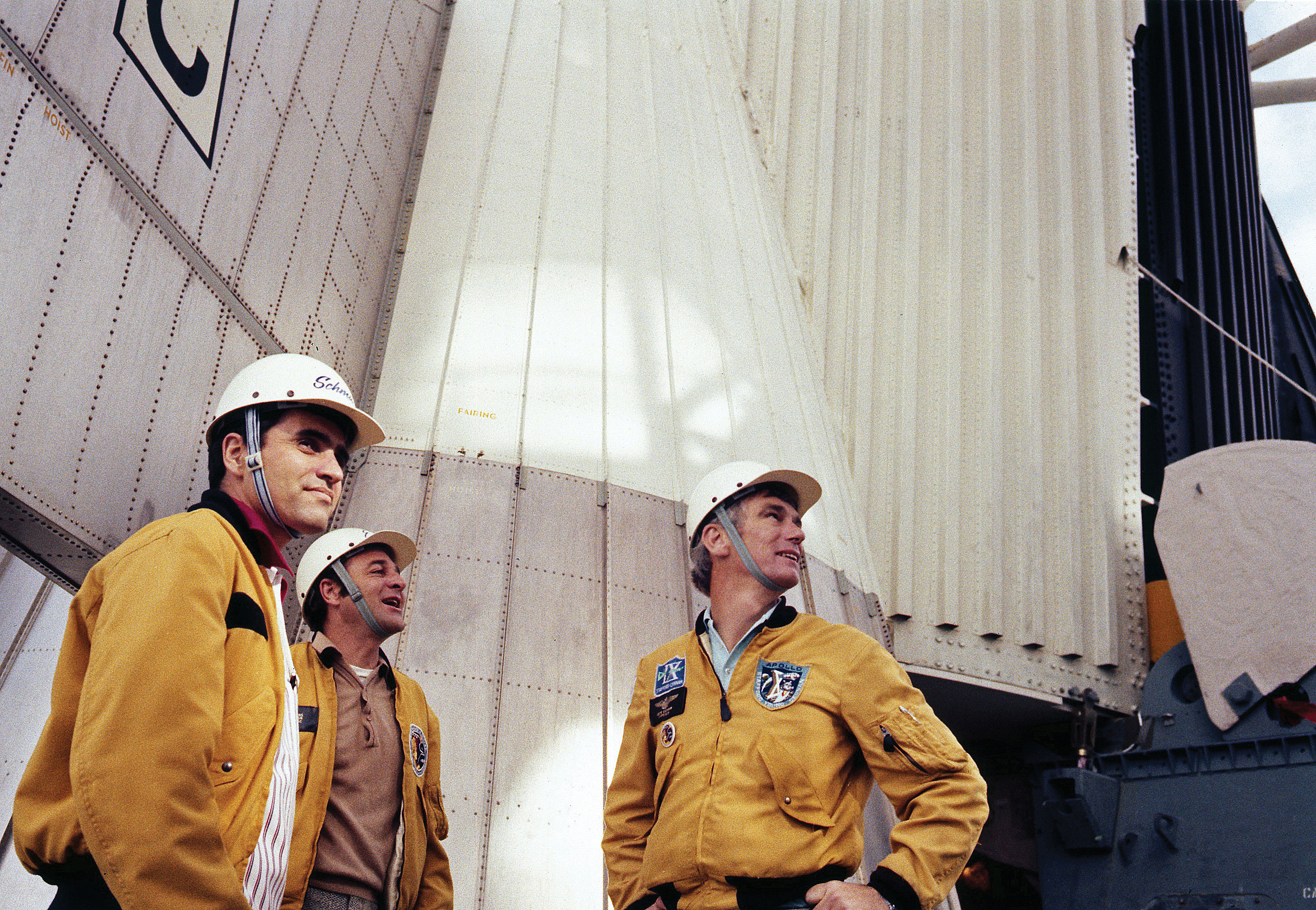
Jack Schmitt, the geologist, simply had to be aboard the final lunar landing mission. Indeed, high-level management discussions had been in progress since March 1971 and NASA Associate Administrator for Manned Space Flight Dale Myers had written to Charlie Townes, chair of the Space Sciences Board of the National Academy of Sciences, assuring him of his support.
Cernan and Evans and their wives, Barbara and Jan, were vacationing in Acapulco when Slayton called them with the Apollo 17 news. Cernan flashed a thumbs-up to Evans, to signify that the two would fly together, but was stopped short in his tracks when Slayton called him back to Houston to “discuss” the rest of his crew.
“The four of us adjourned to the bar for a few rounds of rum and Coke,” he said of that evening on Mexico’s Pacific coast, “elated because we had gotten what we wanted, but disappointed, too. Even without being told, we knew that Deke probably had been forced to shuffle the crew, that Jack was going to fly and Joe was going to stay home.”
Engle was bitter, but handled his predicament with grace and dignity. A month later, on 8 September, he told Jim Maloney of the Houston Post that “when something like this happens, you can do one of two things. You can lay on the bed and cry about it, or you can get behind the mission and make it the best in the world”.
It is testament to Engle’s integrity and strength of character that he put his own feelings to one side and rededicated himself to helping Schmitt perfect his skills as a lunar module pilot.
The wives thought differently, at least at first. Barbara Cernan and Jan Evans had formed close relationships with Joe and Mary Engle and were devastated at the loss. Schmitt was a bachelor and Cernan worried about whether he could mould the civilian into a member of his team.
Schmitt apparently had little regard for the military chain of command to which most astronauts had become accustomed.
At length, Cernan sat Schmitt down with the bottom line. NASA may be a civilian agency, but its leaders came from military services, where the commander’s word was final. “We could discuss differences and problems,” Cernan wrote in his memoir, “but the old Supreme Being argument had to apply.”
The consensus was that Schmitt would work through Cernan, like it or not. Or in Cernan’s words: “Period. End of story. Sit down.”
Schmitt sat down. In time, the duo developed immense respect for each other and Cernan gave his geologist responsibility for planning virtually every science aspect of their three days on the Moon.
Chapter Two: Unpicking the Men
The names of Cernan, Evans, and Schmitt were revealed by NASA on 13 August 1971 and, in keeping with convention, the identities of a backup crew were also publicized.
Since Jack Schmitt was the only professional geologist in the astronaut corps at the time, it seemed unlikely that even a broken leg would prevent him from flying, and the backup team knew this.
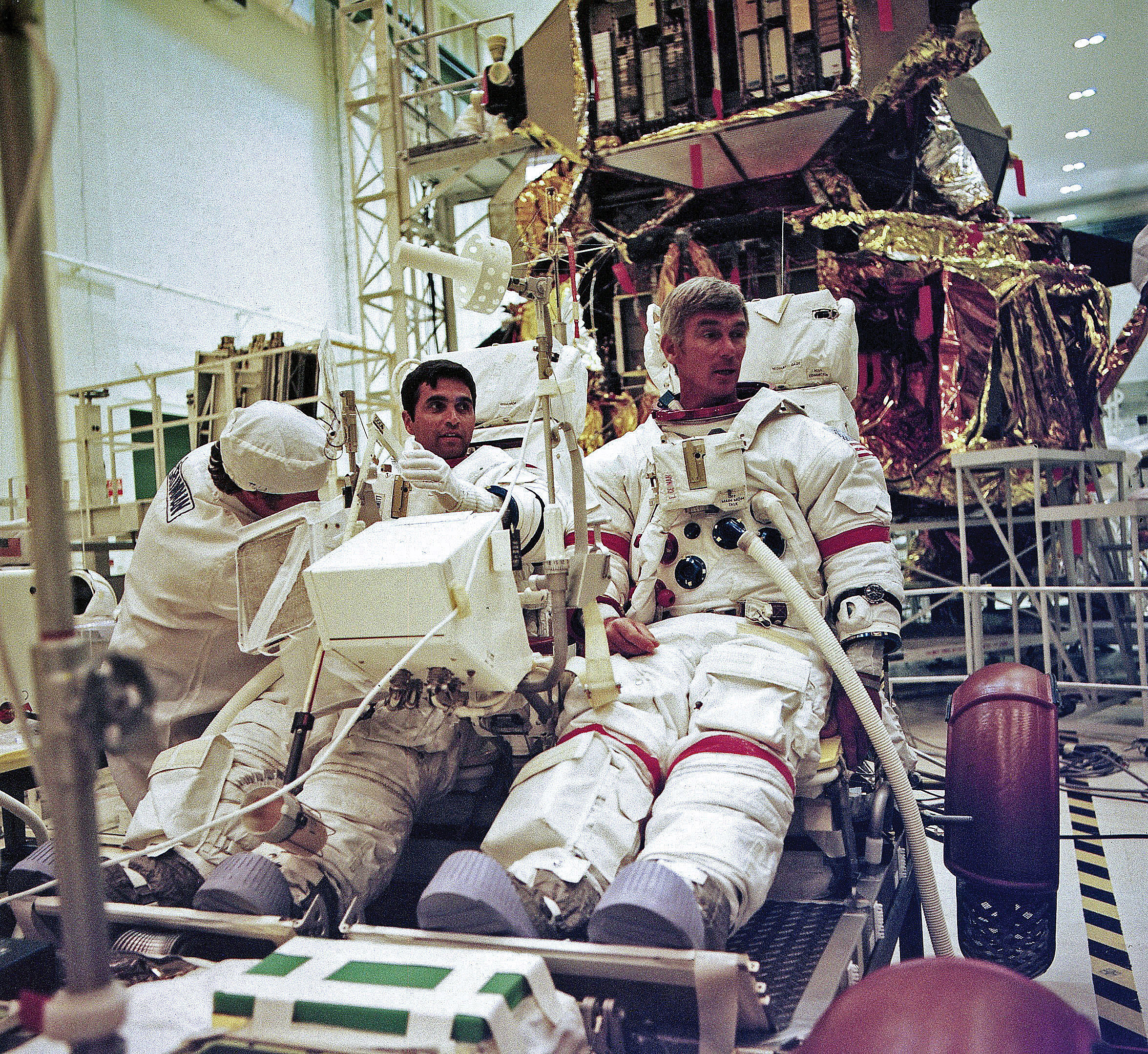
Assigned to this somewhat unenviable role were astronauts Dave Scott, Al Worden, and Jim Irwin, who had recently returned from the Moon on Apollo 15. However, their assignment was terminated a few months later, when the three men became embroiled in a particularly ugly scandal which would tarnish their individual reputations as well as the astronaut corps itself.
Scott, Worden, and Irwin had carried a stack of first-day philatelic covers to the Moon on Apollo 15, part of an arrangement with a stamp dealer, with the intention of selling them and setting up trust funds for their children.
The problem was that the 400 total covers—a hundred for each astronaut and the remainder for a German dealer, Walter Eiermann—had not been authorised by NASA. According to the terms of the deal with Eiermann, the covers would be sold exclusively (and privately) to collectors, with no publicity, after the end of the Apollo programme, with Scott, Worden, and Irwin expecting to receive around $8,000 apiece.
Eiermann, however, began selling them within weeks and the furious astronauts contacted him in October 1971 and tried to cancel the agreement. It was too late. The story had leaked into the European press and some covers were already fetching $1,500 each.
It is important to stress that none of the astronauts accepted any money and when Dave Scott admitted to senior managers what happened he was met with NASA’s full fury.
Neither Deke Slayton, the head of Flight Crew Operations, or Chris Kraft, the incoming head of what would become the Johnson Space Center, knew if their activity was wrong or illegal, or not, but they knew it did not smell good. They passed the case to NASA Deputy Administrator George Low, who involved the space agency’s inspector-general and lawyers.
“In a matter of days,” wrote Kraft in his memoir, Flight, “we had a full-scale internal scandal on our hands.” Scott, Worden, and Irwin were removed from active flight status and dropped from the Apollo 17 backup crew.
Their replacements, formally announced in July 1972, were another mix of previous lunar voyagers: newly-returned Apollo 16 moonwalkers John Young and Charlie Duke, teamed with veteran Apollo 14 command module pilot Stu Roosa.
Previously, Slayton tried to offer positions to “rookie” astronauts, but with no more missions on the horizon there seemed little sense in training first-timers for a “dead-end” backup stint. For his part, Roosa accepted the Apollo 17 assignment, even with a one-in-a-million chance of flying, but Duke—who would back up Jack Schmitt—knew that he would never fly.
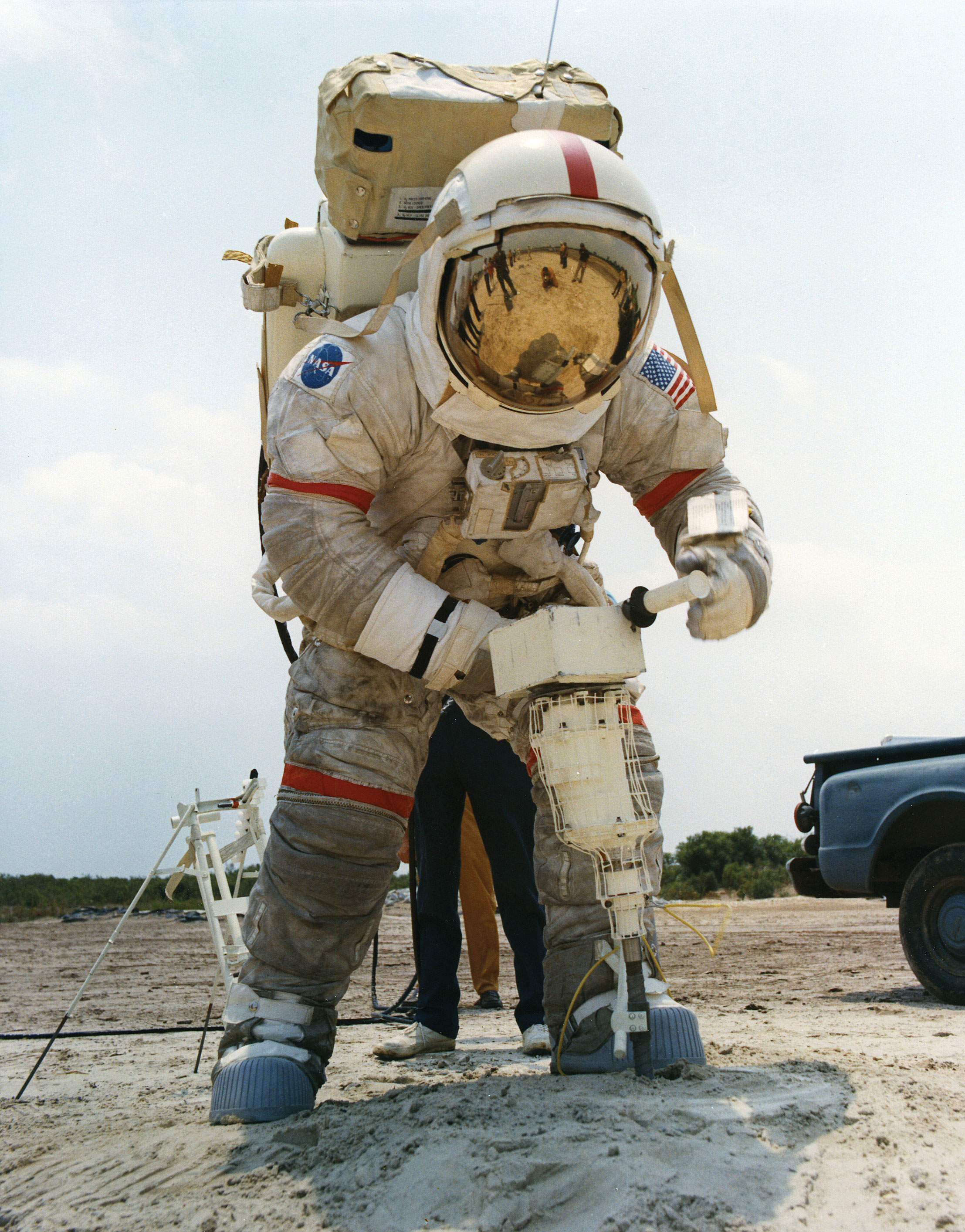
For John Young, he would stick around for whatever missions he could get…and late in 1972 he came within a whisker of seizing the Apollo 17 command for himself.
During their time together, the new backups developed a camaraderie and even jokingly grew moustaches. John Young added more depth in his memoir, Forever Young. “We supported the Apollo 17 crew as best we could,” he wrote. “Honestly, Charlie and Stu and I never wanted anything but the prime crew actually to make the launch; in fact, the three of us all grew moustaches and vowed not to shave them until those guys got off the launch pad.”
By the time the new backup team began training, Cernan and his men had already completed a dozen geology field trips and Young’s crew joined them for visits to Stillwater in Montana, the Nevada nuclear test site, Tonopah in Nevada, Blackhawk Landslide in southern California’s San Bernardino Mountains, the inhospitable Mojave Desert, and Flagstaff—where Jack Schmitt had earlier worked as an astrogeologist—in Arizona.
On one of those occasions, near Tonopah—midway between Reno and Las Vegas—the backup crew’s geologist driver sheared off part of the suspension system of his station wagon and left them stranded on the cusp of sundown.
“The Apollo 17 prime crew was two miles away in a different vehicle,” wrote Young, “and about to begin driving back to Tonopah. I ran all that way to get them to stop by waving my arms. They did stop, picked me up, and went back up the hill to get Charlie and our geology trainers.”
Had Young not done this, they would have been obliged to spend the night in the desert with no camping equipment. “It would not have been a fun night out of town,” Young concluded.
By the time that Young, Roosa, and Duke joined the mission, a primary landing site for Apollo 17 had been chosen. In November 1971, the planning process began.
In the ‘Apollo Lunar Surface Journal,’ Eric Jones wrote that “the flight planners wanted a site far enough from the [Moon’s] eastern limb that they would have at least 12 minutes of flying time—and preferably 15 minutes—before Acquisition of Signal and the start of the final descent.” This enforced a demand of possible sites being no further east than a lunar longitude of 34 degrees, and in a memo dated 23 November, Jim McDivitt, head of the Apollo Spacecraft Program Office, declared that only in cases of extraordinary scientific merit should a site outside those parameters be considered.
The final decision of the Taurus-Littow valley was made in February 1972. Ironically, one of the key factors in the decision was the imagery acquired by the Apollo 15 crew from lunar orbit.
Years later, Cernan wrote that the site was so far off the “usual” track that it did not have a name and was thus dubbed ‘Taurus-Littrow’. Its steep-sided mountains were expected to yield rock and soil samples from before the calamitous Mare Imbrium impact—a major collision event in early lunar history, which produced a 700-mile-wide crater that is today best recognized as the Man in the Moon’s right eye—and its dark-colored surface was peculiarly distinct from the brighter highlands around it.
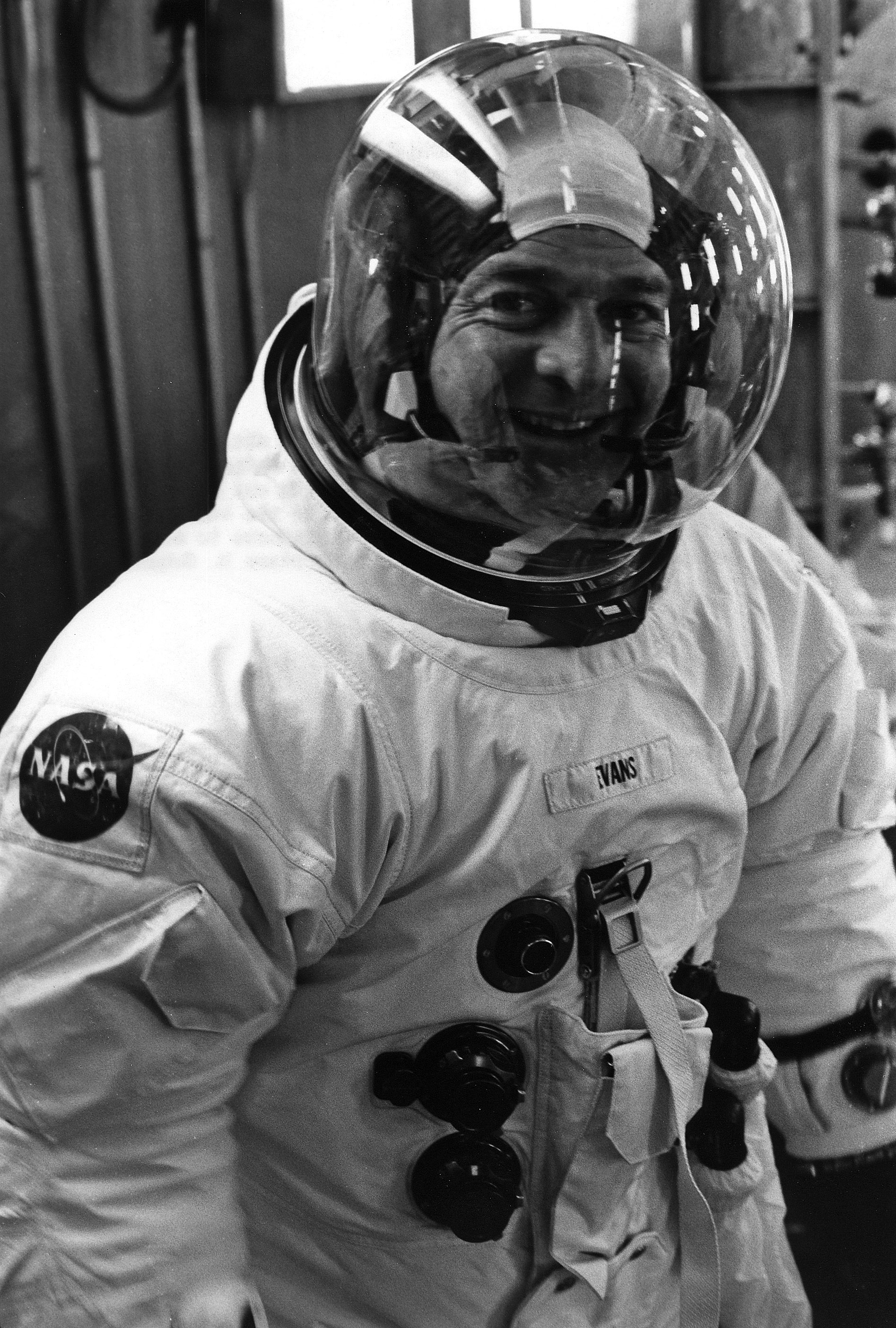
In fact, the valley possessed some of the darkest material ever seen on the Moon.
“The targeted landing point itself,” explained the NASA news release on 16 February, “will be on the other prime sampling objective, which is the very dark, non-mare material filling the valleys between the mountains.”
On Earth, such geological events can occur when pockets of high-pressure volcanic gas find release at the surface and spray droplets of lava in a veritable “fire fountain”; if this had happened at Taurus-Littrow it was expected to have blanketed a wide area with volcanic material.
During his observations from orbit on Apollo 15, Al Worden described what he thought were “cinder cones” in the region and suggested over the radio that it might be a highly desirable spot for a future landing.
If Taurus-Littrow was volcanic in origin, its relatively low crater density and dark material led to intense speculation that it was one of the youngest such areas on the Moon. At the same time, the North and South Massifs, which bounded the valley, were expected to produce more ancient rocks and the Sculptured Hills appeared to hint at highland volcanism.
If Charlie Duke intuitively knew that he would never gain a seat on Apollo 17 for real, that opportunity came tantalizingly close for John Young, in spite of his assertion that he wanted nothing more than for the prime crew to fly.
Two unexpected situations arose in the latter part of 1972. The first came in the weeks after the infamous massacre of Olympic athletes in Munich in early September, and there was talk that Black September militants were targeting the high-profile Apollo 17 crew and their children.
Cernan was incensed by this threat to their children’s lives and in the final weeks before launch armed police sat in unmarked cars, 24 hours per day, monitoring the astronauts’ homes. Meanwhile, during the day, well-dressed, exceptionally polite and heavily-armed federal agents sat in the classrooms of the Cernan and Evans children.
During this time, a routine physical exam showed up a prostate infection in Cernan himself. Dr. Chuck La Pinta, the flight surgeon, kept discreetly quiet and treated him accordingly. Years later, Cernan would praise La Pinta as one of few doctors who did not ring alarm bells…but then something else happened which almost scuppered his chance of flying Apollo 17 altogether.
One day in October, the crew was playing softball at Cape Kennedy, when Cernan felt something “snap” in his right leg. Fearing a ruptured tendon, he had to be carried away by Evans and Schmitt.
La Pinta’s prognosis was not good. If the tendon was ruptured, it would take months to heal—and Apollo 17 was scheduled for launch in barely six weeks’ time—and if not it would still require several weeks of bedrest and time on crutches. Thankfully, when the X-ray results came back, they showed no rupture, but La Pinta told Cernan categorically not to overly tax himself. If he did, the tendon might tear and his chance of flying Apollo 17 would be gone for good.
La Pinta kept Cernan shielded from the managers, who feared the worst. At length, the doctor’s treatment and advice worked and Cernan later paid glowing tribute to La Pinta for his discretion. He was, wrote Cernan, “a great doctor, a terrific liar…and an even better friend.”
Chapter Three: End of the Beginning
The National Academy of Sciences had long pressured NASA to fly its only formally qualified geologist-astronaut, Schmitt, on a lunar landing mission and the space agency eventually caved in.
Yet flying Schmitt on Apollo 17 simply because he happened to be a geologist, and had contributed enormously to the programme, was not enough, and NASA senior managers would have fought the scientists and politicians tooth and nail if the man nicknamed ‘Dr Rock’ was not up to the task.
Many questions were asked as to how useful Schmitt would really be – encased in a bulky suit, with only minutes available at each geological sampling stop to make judgements and observations – and the fact remained that going to the Moon was fraught with intense risk.
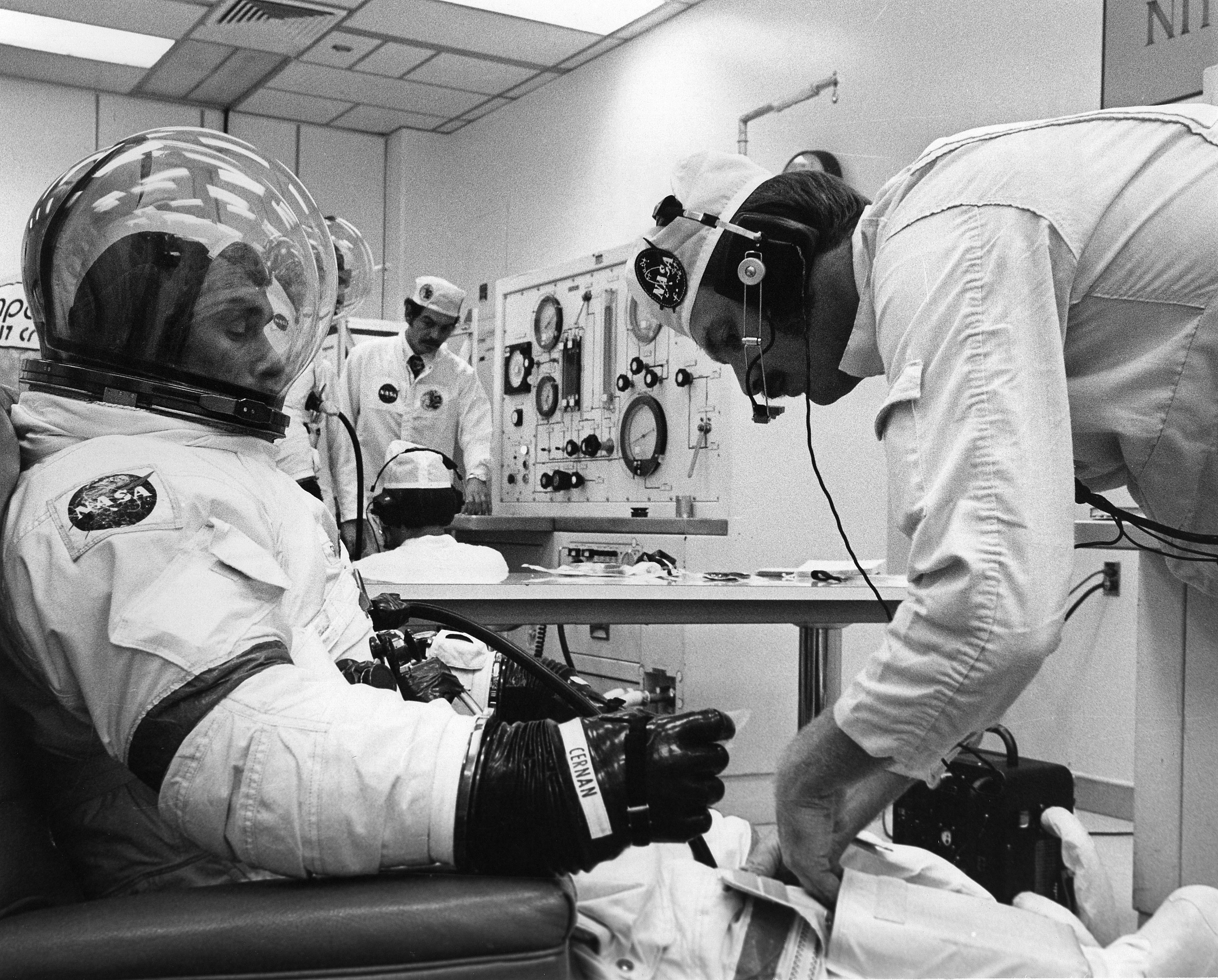
One day, early in 1972, Chris Kraft – the legendary flight director who had recently been appointed Director of the Manned Spacecraft Center in Houston – took Gene Cernan to one side.
“Geno,” he began, “put away that fighter pilot’s silk scarf and just bring your crew home alive. If you run into something you don’t like out there and decide not to land, I’ll back you one hundred percent.”
Cernan felt quite differently. The very fact that Apollo 17 was to be the final mission of the programme made him even more bold, and he impressed on the journalists, the workers building and checking out their spacecraft and the politicians that this was not the ‘end’, but the ‘end of the beginning’.
However, as our generation knows, Apollo 17 was the end. For two years, NASA’s workforce had been in decline and President Richard Nixon’s budget cuts had made this immensely painful for those giants who had made possible the greatest achievement in human history.
Although Cernan meant it with all sincerity, his words grew to become a popular joke: a cartoonist drew a pair of workers at the top of a scaffold, one holding a notice informing him that he had just been fired. The other man was on the telephone, saying “Can we get Gene Cernan up here to give Smith that ‘it’s not the end, it’s the beginning’ speech again?”
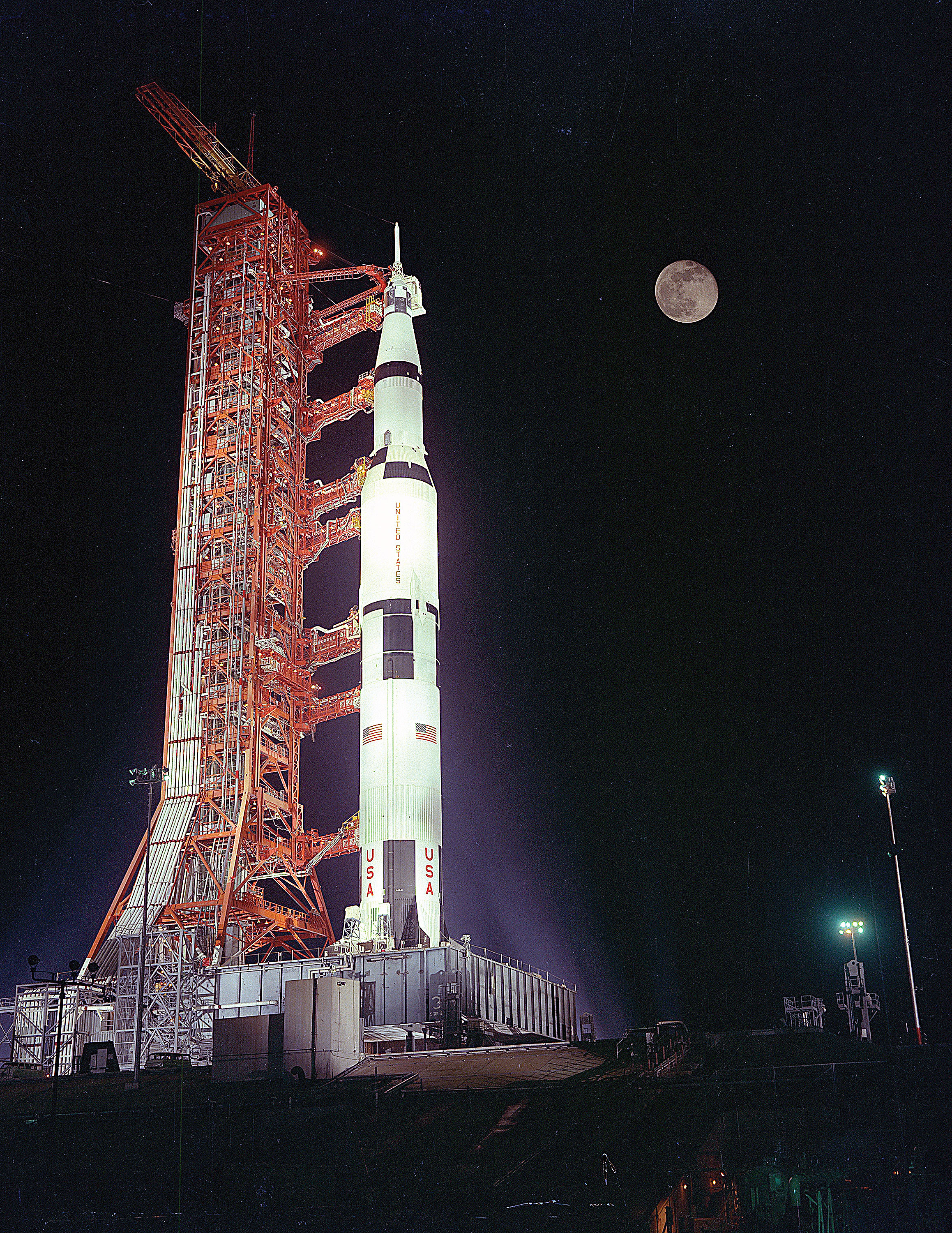
Credit: NASA via J.L. Pickering/Retro Space Images
By the evening of 6 December 1972, all was ready. The gigantic Saturn V gleamed under the floodlights as it was readied for its only night-time launch. Even today, it remains the largest and most powerful rocket ever brought to operational status.
Cernan, Evans and Schmitt proceeded through the ritual of a steak-and-eggs breakfast, after which they were helped into their bulky suits. At length, all three men were ensconced in their seats in the command module, which they had named ‘America’.
Launch was scheduled for 9:53 pm EST, at the start of a four-hour ‘window’, and the countdown proceeded smoothly…until the first glitch reared its head. The automated launch sequencer on the ground failed to properly command the oxygen tank of the Saturn V’s third stage to pressurise. The launch controllers issued the command manually, but the sequencer knew that it had not sent the command and refused to proceed. Eventually, a work-around procedure was devised and the countdown clock resumed ticking a few minutes before midnight.
Finally, at 12:33 am on 7 December, the Saturn took flight, stunning the assembled crowds and most of America’s East Coast with a spectacle rivalling sunrise. “It’s lighting up the sky,” announced public affairs commentator Jack King with astonishment. “It’s just like daylight here at the Kennedy Space Center!”
From his left-hand couch, Cernan could clearly see the fiery glow reflecting off the clouds and the shuddering cabin seemed ‘painted’ with a fearsome reddish hue. Ron Evans and Jack Schmitt, experiencing their first ride into space, were jubilant.
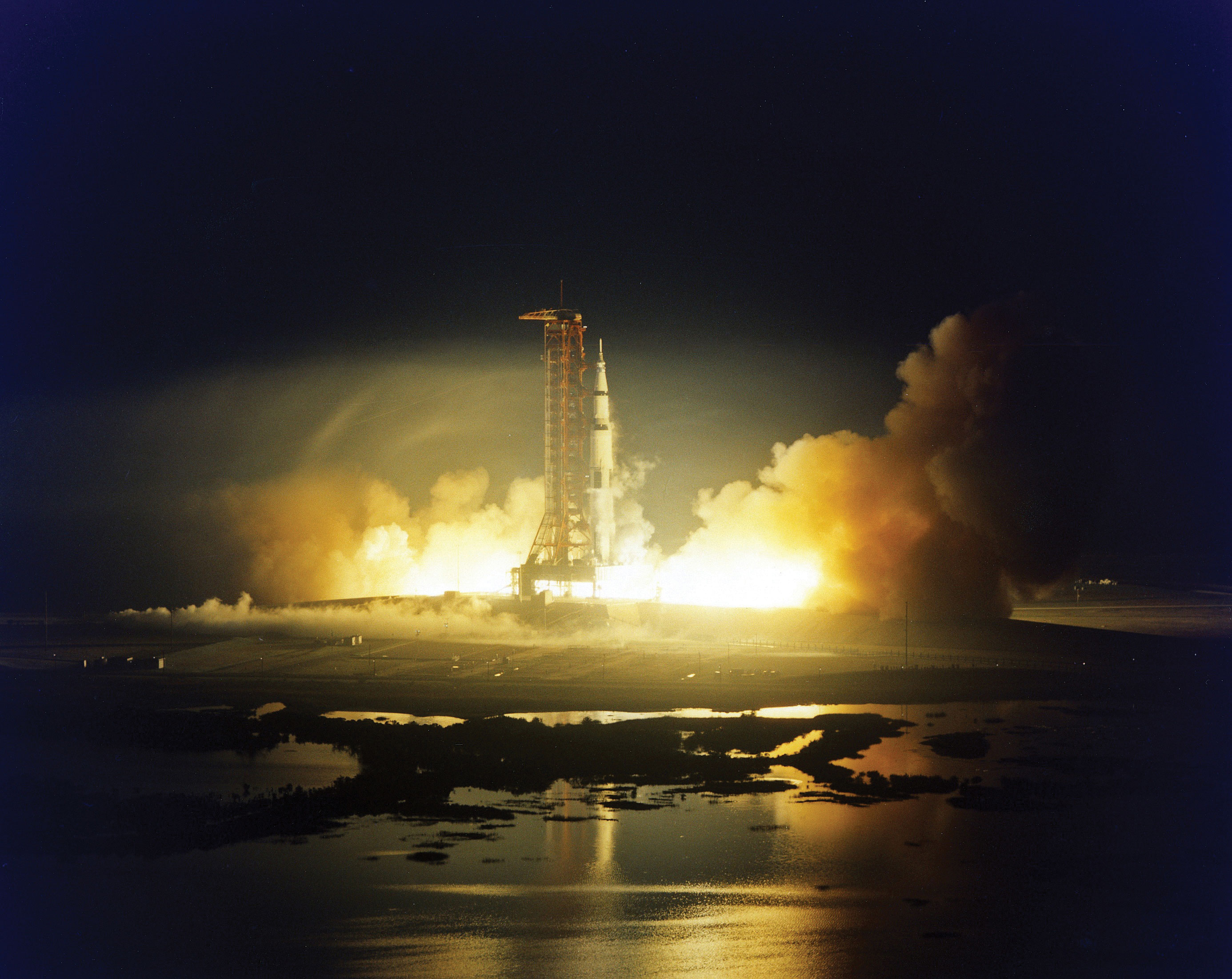
Shortly after midday on the 11th, the command and service module America and lunar module Challenger parted company in orbit around the Moon and Cernan and Schmitt steeled themselves for their Powered Descent to land at Taurus-Littrow. By this time, Cernan was an old hand at such matters, having flown down to just nine miles above the Moon on Apollo 10.
“Thanks to the simulators back on Earth, with their computer-enhanced photos of the approach to the landing site,” Cernan wrote in his autobiography, The Last Man on the Moon, “I knew this place better than I knew my own palm and there were no surprises as we zoomed toward the jagged highlands that separate the Sea of Tranquillity from the Sea of Serenity. I called out the passing landmarks that verified we were on track to the narrow entrance to the Valley of Taurus-Littrow.”
Dropping closer now, both men’s eyes remained on their instruments…until Cernan spotted something that he wanted Schmitt to take a look at. Halfway through the 12-minute burn of Challenger’s descent engine, he told Schmitt to look at “something spectacular” outside his window. Expecting to see some unexpected jewel of lunar geology, Schmitt looked; but he couldn’t see a thing, he said, except for the blue and white globe of Earth.
“That’s what I’m telling you to look at!” chuckled Cernan.
Two miles above the Moon, and by now plunging like a fast elevator, the Earth hung in the black sky, directly in front of Challenger’s triangular windows.
“Down we flew toward crop-duster altitudes,” Cernan wrote, “scooted over the dome-like Sculptured Hills, some of which were more than a mile high, and roared into the eastern entrance of a crater-pocked lunar valley deeper than the Grand Canyon, surrounded by mountains whose crests were above us.”

As Schmitt called out altitudes and approach angles, Cernan confidently set Challenger down on a smooth spot at 2:54 pm EST.
At last, less than five days since leaving Florida, they were here. Paradoxically, the cacophony of roaring and groaning and screaming and shuddering which the Saturn V had unleashed as it climbed for the heavens were gone…to be replaced by the absolute silence, ethereal stillness, perfect serenity and utter lifelessness of the Moon’s Taurus-Littrow valley. To their right, the North Massif stood taller than eight Eiffel Towers and to their left the “wretched slab” of the South Massif equalled the height of half a dozen Empire State Buildings, stacked one atop the other.
Four hours later, at 6:54 pm, Cernan shuffled his way down Challenger’s ladder and planted his boots into the soft lunar regolith. Shortly afterwards, he was joined by Jack Schmitt and the men set about their first tasks.
Moving around was tricky to start with: only ten other humans had gone from terrestrial gravity to weightlessness to one-sixth gravity and Cernan and Schmitt bobbed around like rubber ducks in a bathtub. At length, the geologist in Schmitt overcame the awestruck voyager: the soil, he radioed, looked “like a vesicular, very light-coloured porphyry of some kind; it’s about 10 or 15 percent vesicles”. It was also extremely dirty; the dust clung to their suits, to their visors and to their gloves, with the result that within minutes Cernan looked like he had been outside for a week. Trying to brush it away made matters worse.
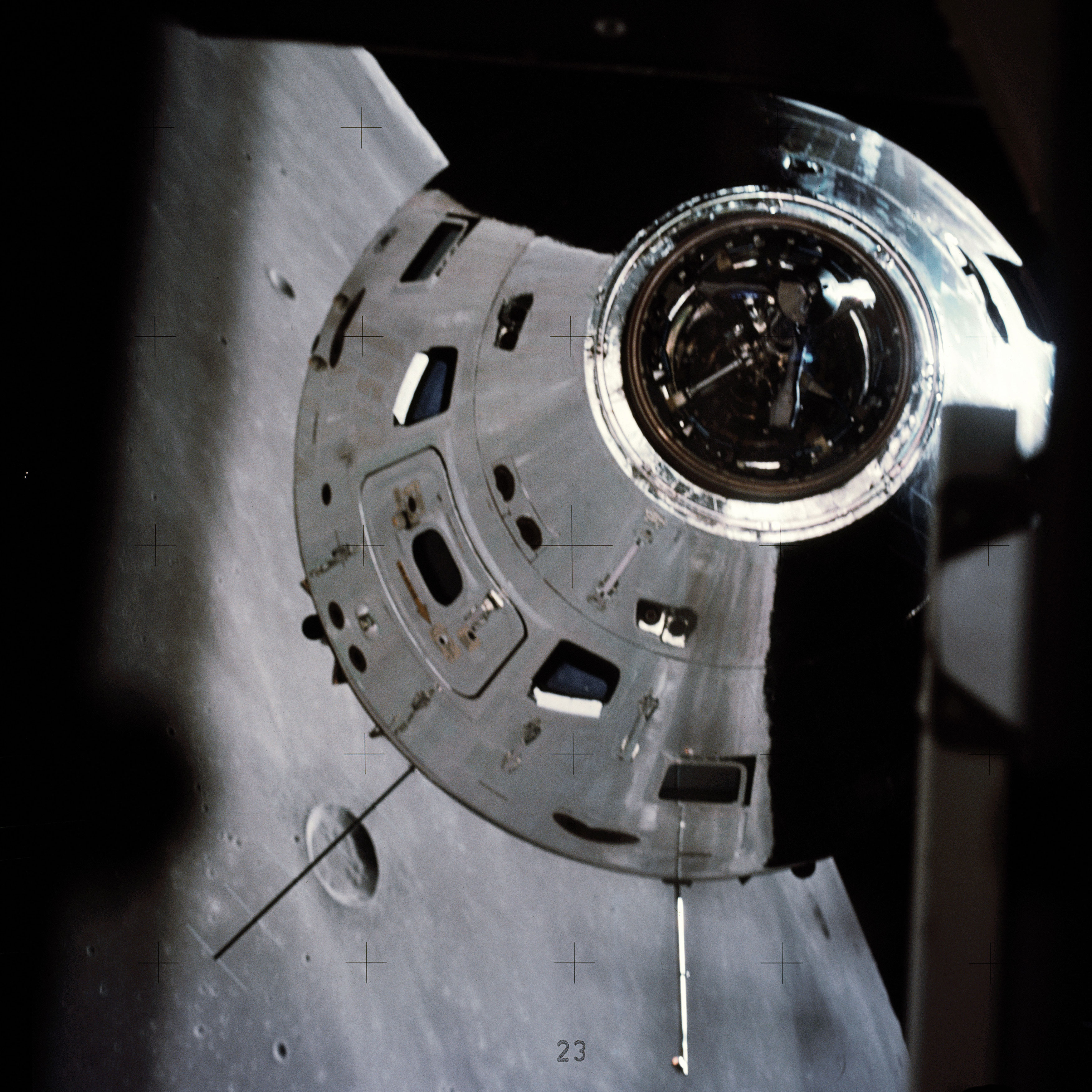
At one point, reaching to pick up a rock, Schmitt slipped and, laughing, tumbled into the dust: his pure-white suit ended up charcoal grey from the knees down…
“You adapt very, very quickly,” Cernan later told Eric Jones of the ‘Apollo Lunar Surface Journal’. “You very quickly realise – probably in the first couple of minutes – that you don’t need to take baby steps or regular steps to get anywhere.
“Somehow your brain and your body co-ordinate your movements and if you’re going to go any distance, you start skipping or hop-skipping to get where you’re going. It’s not like you start running,” contnued Cernan. “It’s just that you move with such ease. Later on, when you start moving at faster paces than we were doing here, if you decide to turn or change directions, you have to think about your high centre-of-mass and plan how you’re going to handle that…or you’re going to go tail-over-tea kettle…but you adapt very readily, physiologically and psychologically. You’re conscious, as soon as you’re on the surface, that you’re in this one-sixth-G environment and that you can move around so much more easily. The human being is a very unique, very adaptable creature.”
Their first major task was to unpack the lunar rover from Challenger’s descent stage; for the next three days, they would rely upon its capabilities. Unreeling lanyards and watching the framework fold into place was, wrote Cernan, like assembling a Christmas bike for his daughter, Tracy. “Hallelujah, Houston,” yelled Cernan as he took it for a test drive. “Challenger’s baby is on the roll!”
As they loaded their tools aboard the rover, Cernan kept looking up at the Earth, hanging like a decoration in the sky above the South Massif. At one stage, he even told Schmitt to take a look for half a minute: the geologist owed himself that much. Schmitt, a man who had spent his life exploring the rocks and soils of that blue-and-white world, feigned disgust.
“What? The Earth?”
“Just look up there!”
“Aaaahhh,” drawled Schmitt. “You seen one Earth, you’ve seen ’em all!”
By now Cernan was familiar with Schmitt’s dry humour and good-natured sarcasm, but in his autobiography he expressed disappointment at how off-handedly the geologist dismissed this awe-inspiring sight.
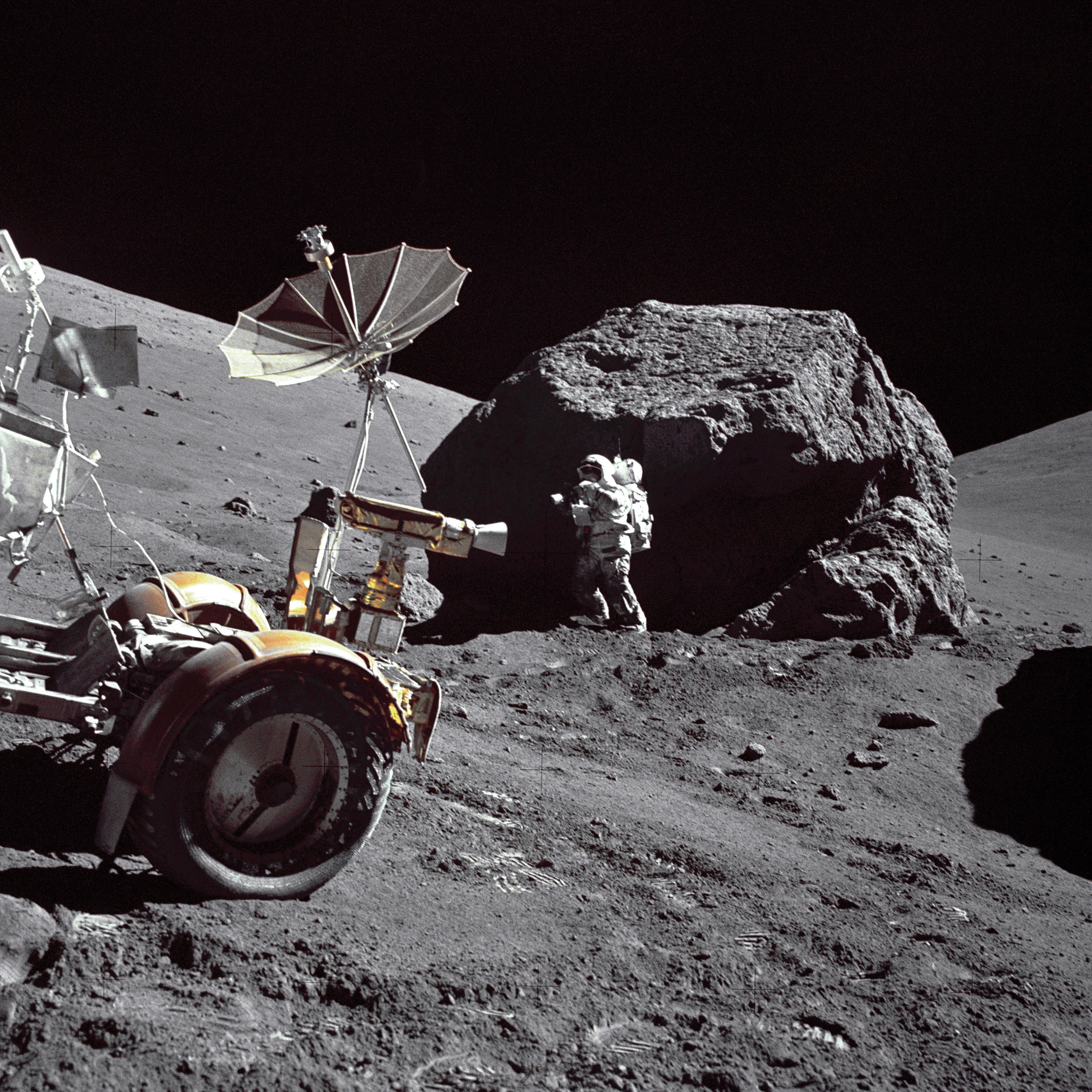
Before the launch, Cernan had urged Schmitt and Ron Evans to embrace each and every experience from this mission since it was sure to be the most remarkable and breathtaking and exhilarating adventure of their lives, and he also knew that none of them would ever come this way again.
It was perhaps with this in mind that, after erecting the Stars and Stripes, during which Cernan managed to capture a now iconic image of his colleague with Earth in the background, they set to work assembling their own package of experiments, the Apollo Lunar Surface Experiments Package (ALSEP), which would relay data from this strange place.
Many of the ALSEP experiments on Apollo 17 were new ones. The Lunar Ejecta and Meteorites investigation tracked tiny particles impacting the surface.
A seismic profiling sensor featured four geophones arranged in an equilateral triangle – one at each point and one in the centre – which measured small explosive charges to be detonated after the astronauts had left the Moon, in order to better understand the structure of the surface.
Elsewhere, another instrument monitored the tenuous lunar atmosphere. A ‘gravimeter’ was carried on the rover to investigate the deep structure of the valley floor. A second gravimeter, of a completely different type, was set up at the ALSEP site. This was a speculative venture.
Although Einstein’s theory of relativity predicted the existence of gravity waves, they had proved difficult to confirm. Working with a counterpart on Earth, any signal detected by just one instrument could not be a gravity wave, but a signal sensed by both could only be a gravity wave passing through the Solar System. In effect, this instrument was a highly sensitive seismometer.
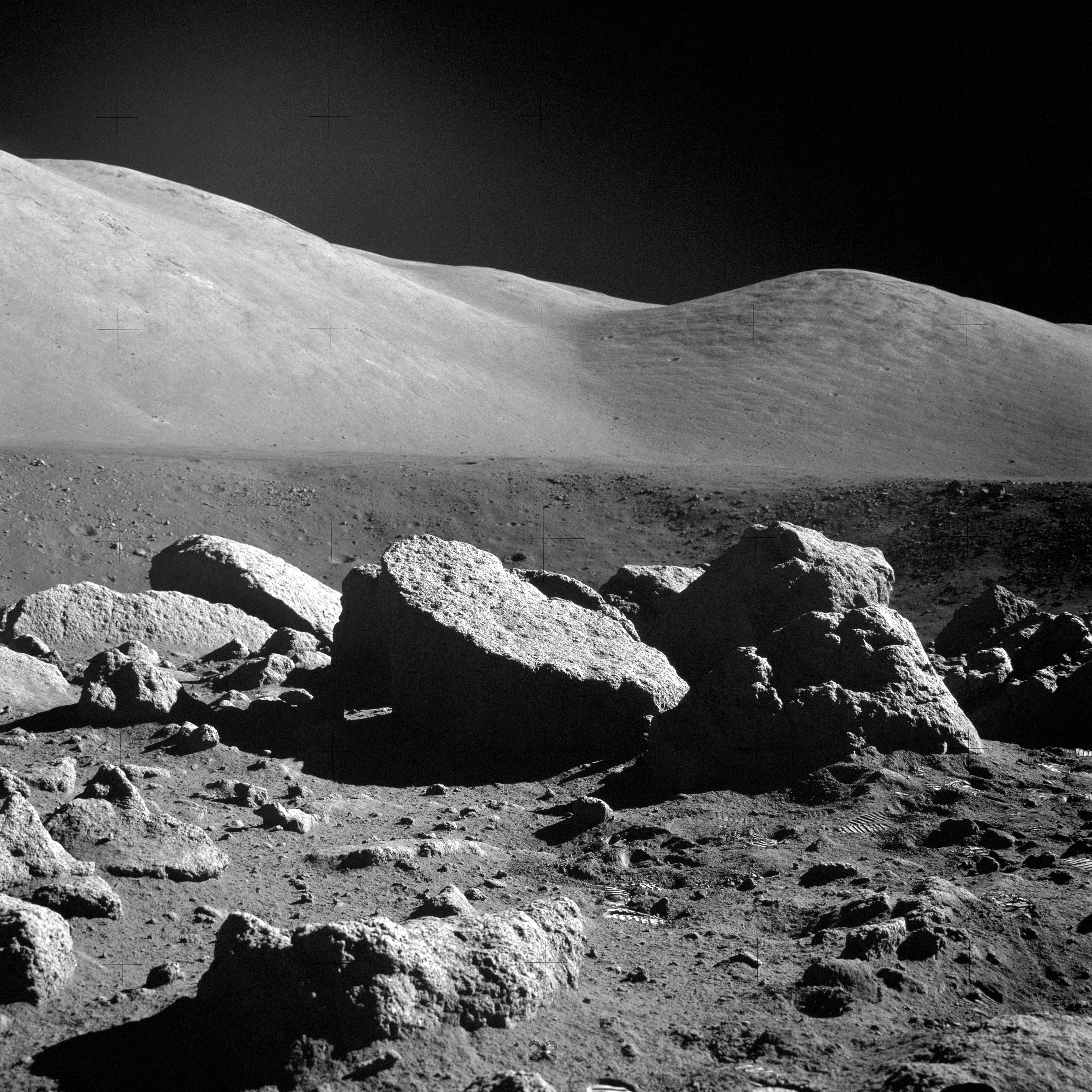
Geophysicist Marcus Langseth, sitting in Mission Control in Houston, was pleased to see Cernan boring three holes into the surface for his heat-flow investigation, although it was tough work.
“I had to grip it tightly,” wrote Cernan, “and force my whole weight on it, but progress was no better than haphazard. The drill would find easy access for a few inches, then clunk against rock and kick back. My heart rate went up to 150 beats per minute, my hands hurt from squeezing the handle and dust swirled in a sticky haze.”
Cernan’s increased heart rate alarmed flight surgeons and he ate seriously into his oxygen supply. After a while, Flight Director Gerry Griffin told Capcom Bob Parker to ask Schmitt to help Cernan extract the deep core sample from the ground. For his own part, the geologist had his own troubles with the gravimeter – it needed to be perfectly level and, at length, a slightly exasperated Schmitt was forced to give it a good whack with one of his tools to ‘adjust’ it.
In a sense, his efforts were in vain, because when the instrument was commanded to ‘uncage’ its sensor, a flaw in the mechanism prevented it attaining the sensitivity needed. Still, the instrument was able to detect normal seismic activity.
Called over to help Cernan, Schmitt tried to throw his weight on the jack that was being used to extract the core tube…and abruptly lost his balance and fell flat on his face. This prompted a few chuckles from Houston, but Cernan was worried: had his partner damaged the precious machinery in his backpack? Thankfully, Schmitt was quickly back on his feet.
By the time they finished with the core sample, they were 40 minutes behind schedule. Their first geological traverse would have to be shortened. “Instead of the mile-and-a-half trip south to [the crater] Emory,” wrote Cernan, “we would stop halfway, in a boulder field near the crater Steno.”
Schmitt was unhappy at losing part of their traverse – in fact, at their single geology stop somewhere near a crater named Steno, they could do little more than grab a few rocks and a bagful of cobbles and dust with the lunar rake.
Back in the vicinity of Challenger, Schmitt spontaneously broke into song:
“I was strolling on the Moon one day…” he began.
Cernan joined the duet: “…in the merry, merry month of December…no, May!”
“May!” confirmed Schmitt.
“May’s the month!” confirmed Bob Parker.
Schmitt continued: “…When much to my surprise, a pair of bonny eyes…”
“Sorry, guys,” Parker interjected, “but today may be December!”
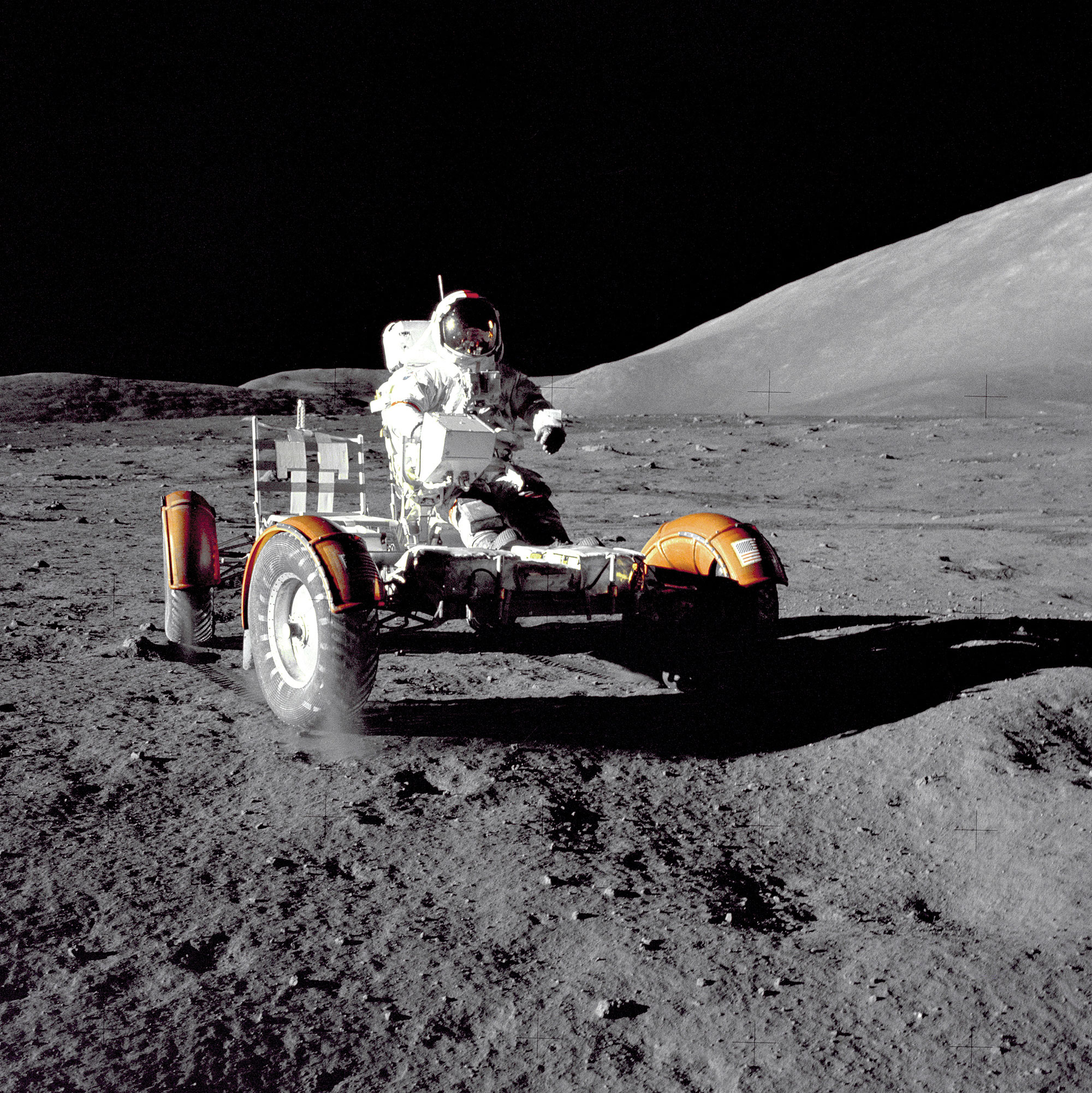
Returning inside the lander after more than seven hours, the two men were exhausted: their forearms ached and, after removing his gloves, Cernan noticed blood under his fingernails, undoubtedly from time spent struggling with the drill.
In his autobiography, he also recalled the unusual sensation of repressurising Challenger’s thin-walled cabin: it was almost as though an oil can had suddenly been filled with air. A loud ‘bloop’ noise was followed by the pressure forcing the hatch to visibly bulge outwards. It reminded Cernan of his visits to Grumman and made him realise how fragile this machine really was.
During their time inside the lander, the astronauts stored their suits at the back of the tiny cabin. However, they were sodden with sweat and in order to dry them in time for the second EVA, Cernan and Schmitt attached the helmets and gloves and hooked up the oxygen hoses to circulate air through them.
“That was like inflating a pair of big balloons,” wrote Cernan, “and it seemed as if two more guys had just crawled into our lunar pup tent.” Their massive backpacks, meanwhile, were hung on the walls.
They had a quick dinner, then debriefed over the radio with Mission Control and, for a few moments, rolled a couple of the rock samples over in their hands. Cernan was amazed. These pieces of regolith had lain undisturbed for maybe three billion years and had been exposed to fearsome solar and cosmic radiation…yet they did not look totally different to samples he had seen on his geology trips on Earth.
By the time Cernan and Schmitt dozed off to sleep for their first night on an alien world, they had already been awake for nearly 24 hours. Like previous crews, they strung their hammocks – Schmitt near the floor, Cernan above – and even without their pressurised suits it could hardly be described as comfortable.
Initially, Cernan was too keyed-up to sleep; his mind raced with plans for tomorrow’s excursion, which was to take them to the South Massif. Every so often, he heard Schmitt breathing steadily, and sneezing occasionally in the midst of so much dust, but otherwise the lander and everything around it were eerily still and silent.
There was no hushed breeze or patter of raindrops, Cernan wrote, or the slightest hint of anything else alive, save the two of them. He was physically and mentally exhausted, yet the irony of sleeping when they only had about 60 hours left on the surface seemed too much: at times, he lifted the window blind and gazed outside at the motionless flag and the Earth slowly rotating in its fixed position above the South Massif.
Chapter Four: “We Shall Return”
Schmitt found, to his pleasure, that the pain in his forearms had disappeared overnight; after the mission, he would guess that his cardiovascular system was so much more efficient in one-sixth gravity that it literally ‘cleansed’ the muscles of lactic acid and other waste products, before they could cause any further damage.
There was also good news when they set foot on the surface. In preparing the lunar rover on the first day, Cernan had snagged the pull-out extension of one of the orange fenders with the handle of the geological hammer in shin pocket. He had repaired it using duct tape, but during the traverse it had become detached, and rained dust down on the vehicle.
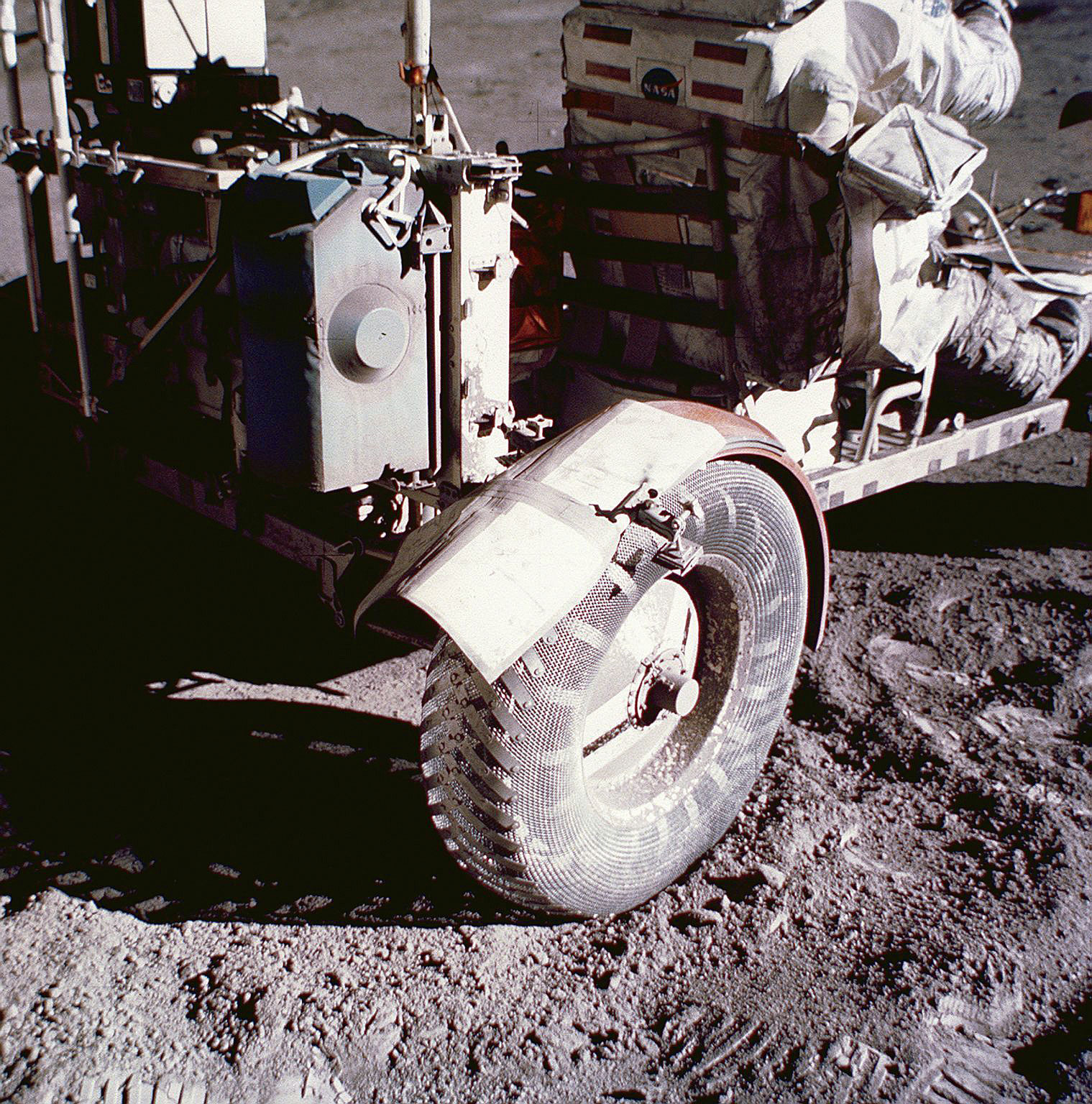
John Young and the backup crew had crafted a repair during the night. Together with the engineers, they had folded four of the crew’s geology maps into a rectangular shape, about the same size as a child’s Halloween mask, and had taped them all together. Cernan and Schmitt were to do the same and then affix it to the remains of the fender using a pair of clamps normally used to hold lamps in the cabin.
This improvisation worked, but it put them a full 80 minutes behind schedule. Nevertheless, Cernan would remember the hour-long drive to the base of the South Massif as one of the most exciting experiences from the entire mission, as he dodged craters and jerked the T-bar to negotiate each ridge and furrow.
On arriving at a broad trough-like depression at the base of the South Massif, they spent an hour sampling boulders which had tumbled down the flank of the 6,000-foot-high mountain. “In fact,” wrote Cernan in his autobiography, The Last Man on the Moon, “we had tapped such a geological goldfield that Houston stretched our time there to the maximum and it was still frustrating to leave such a promising area.”
By now, Cernan was far more than an aviator – if Schmitt had learned to fly a lunar lander, then he had become an exceptional field geologist – and they would find common ground in that there was never enough time to explore properly.
On the Moon, the demands of the clock were forever their enemy. In fact, the trough at the base of the massif was a fairly large crater – called Nansen in honour of the Norwegian explorer Fridtjof Nansen – which had been partially filled in by material which had slumped off the mountain.
For Schmitt, the landscape felt strangely familiar, reminding him of the Alpine valleys he had studied during his days at the University of Oslo.
Cernan and Schmitt were not allowed to drive further from Challenger than they would be able to walk back if the Rover conked out. This walk-back limit was extremely conservative, taking into account the possibility of damaged equipment, excessive oxygen usage and a multitude of other worries, to such an extent that both Cernan and Schmitt had tried to push it as far as they could. Here they hit a solid wall: the walk-back limit would not be compromised.
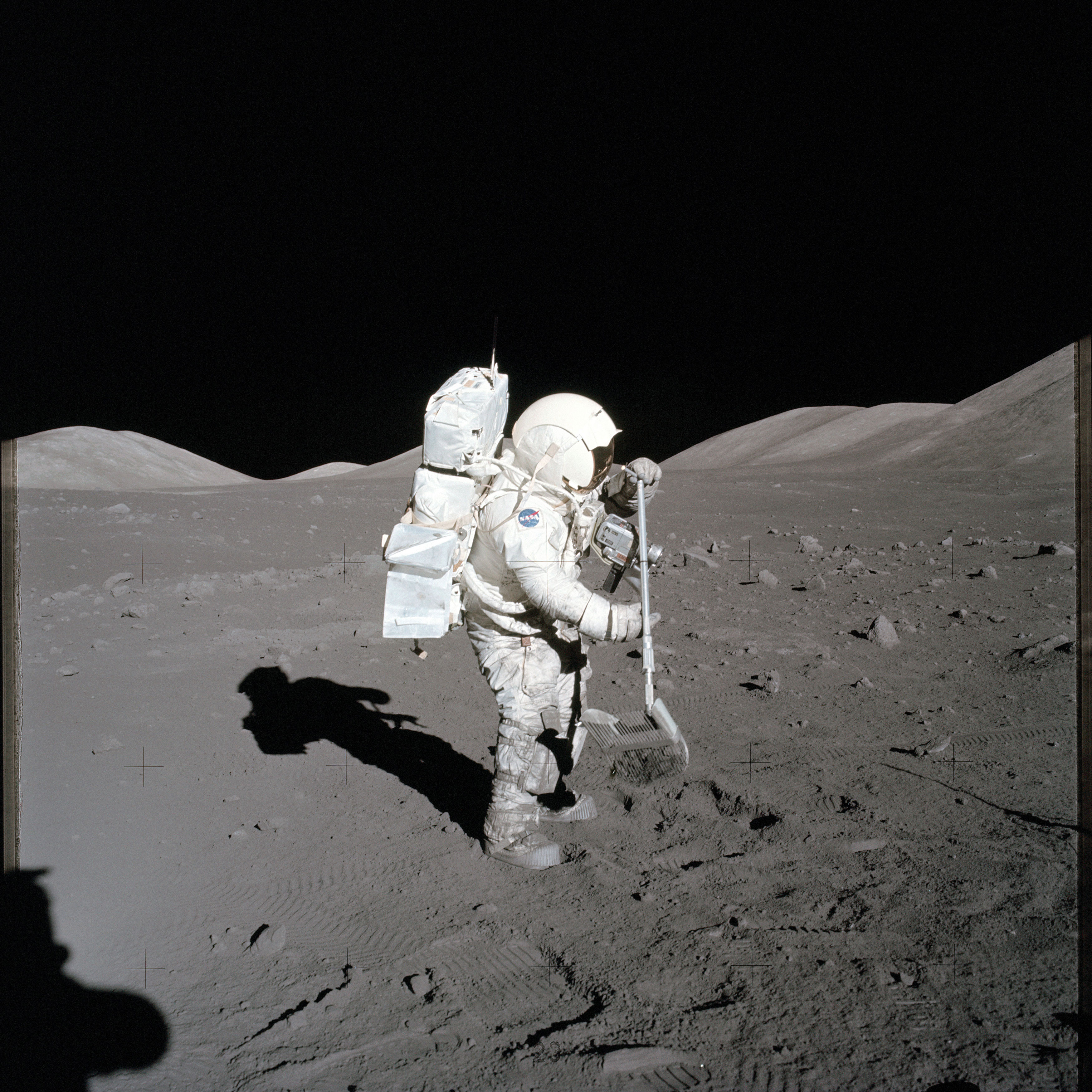
As Apollo 16 Moonwalker Charlie Duke once observed, amidst the grandeur and beauty and serenity of the Moon, it was all too easy to forget the cruel fact that there was a near-total vacuum just inches away from his flesh, and the slightest leak in the suit could spell instantaneous death.
For now, though, frustration was taking its toll. The men would certainly have benefited from longer at Nansen, but they had the craters Lara, Shorty and Camelot to explore. Approaching Lara, Schmitt described what he could see, chiefly for his colleagues in the science support room. While Cernan took a core sample, Schmitt did some solo-sampling and occasionally toppled into the soft lunar dust.
After a while, Parker nicknamed him ‘Twinkletoes’ and radioed that the switchboard at Mission Control was lighting up with calls from the Houston Ballet Foundation, requesting Schmitt’s services, prompting the scientists to start referring to this crater as ‘Ballet’.
It was their next stop, at Shorty Crater, that provided one of the real surprises of the mission.
More than a hundred metres wide, it was, radioed Schmitt, “a darker-rimmed crater…the inner wall is quite blocky…and the impression I have of the mounds in the bottom is that they look like slump masses that may have come off the side”.
Orbital images acquired by Al Worden during Apollo 15 had shown clear evidence of a dark halo around Shorty, which contrasted with the lighter surroundings. It was suggestive of a volcanic explosion crater, and perhaps the source of the dark deposits elsewhere in the Taurus-Littrow region.
Cernan and Schmitt had only half an hour scheduled at this site. Soon after they began sampling, the geologist’s boots scuffed away at the dust and, there before his very eyes, was the ubiquitous grey…and a slight tinge of orange.
Schmitt thought he was imagining it. Was his gold-tinted visor playing a trick on his eyes? He partly lifted the visor; it was still there. Orange soil. He called Cernan, who came bounding over. They confirmed it and jointly agreed that it looked like it had been oxidised, like the rust-coloured soil they had often seen in the desert during their expeditions with geology professor Lee Silver.
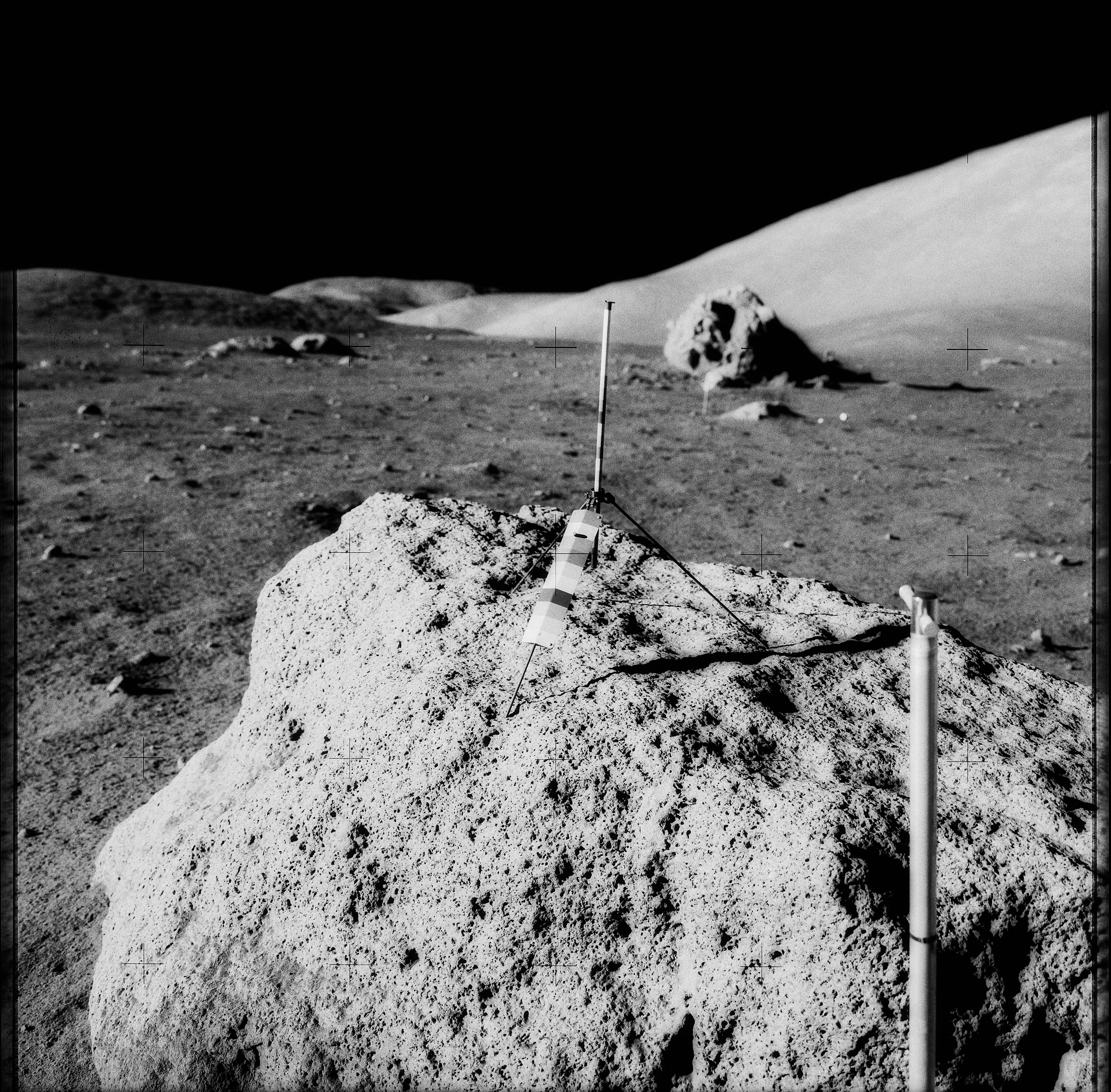
In the science support room, Silver himself was excited: this had to prove that Shorty was a volcanic vent. Cernan was excited: it was, he wrote, unexpected treasure, like a Spanish conquistador finding jungle gold.
Meanwhile, Schmitt set to work digging a trench into the orange deposit in order to trace its extent, and found that it spread along an ellipse-shaped area which ran parallel to the rim of the crater.
In minutes, his opinion of Shortly had changed. When they arrived, he was convinced that it was an impact crater, but now – “if ever I saw a classic alteration halo around a volcanic crater, this is it!”
There was, however, no time to explore further. They had already spent ten minutes longer than planned at Nansen, and the walk-back limit precluded an extension at Shorty.
With only minutes available, Cernan drew his hammer and pounded a core tube into the orange soil at the base of the trench and both men were surprised that when they pulled it out, it was red for part of its length, but a couple of feet down it was a sort of purplish-grey, almost black.
Unfortunately for the volcanic theory of Shorty’s origin, subsequent analysis would show that the orange material was composed of tiny beads of glass which had once been molten lava droplets spewed into the lunar sky in a fire fountain.
“The origin of the fountain,” wrote Andrew Chaikin in his landmark book A Man on the Moon, “was a form of lava that contained dissolved volcanic gases. As it ascended from deep within the Moon to the surface, the effect was that of shaking up a bottle of soda and then uncapping it: the gas rapidly came out of solution, propelling molten rock high into the lunar sky.
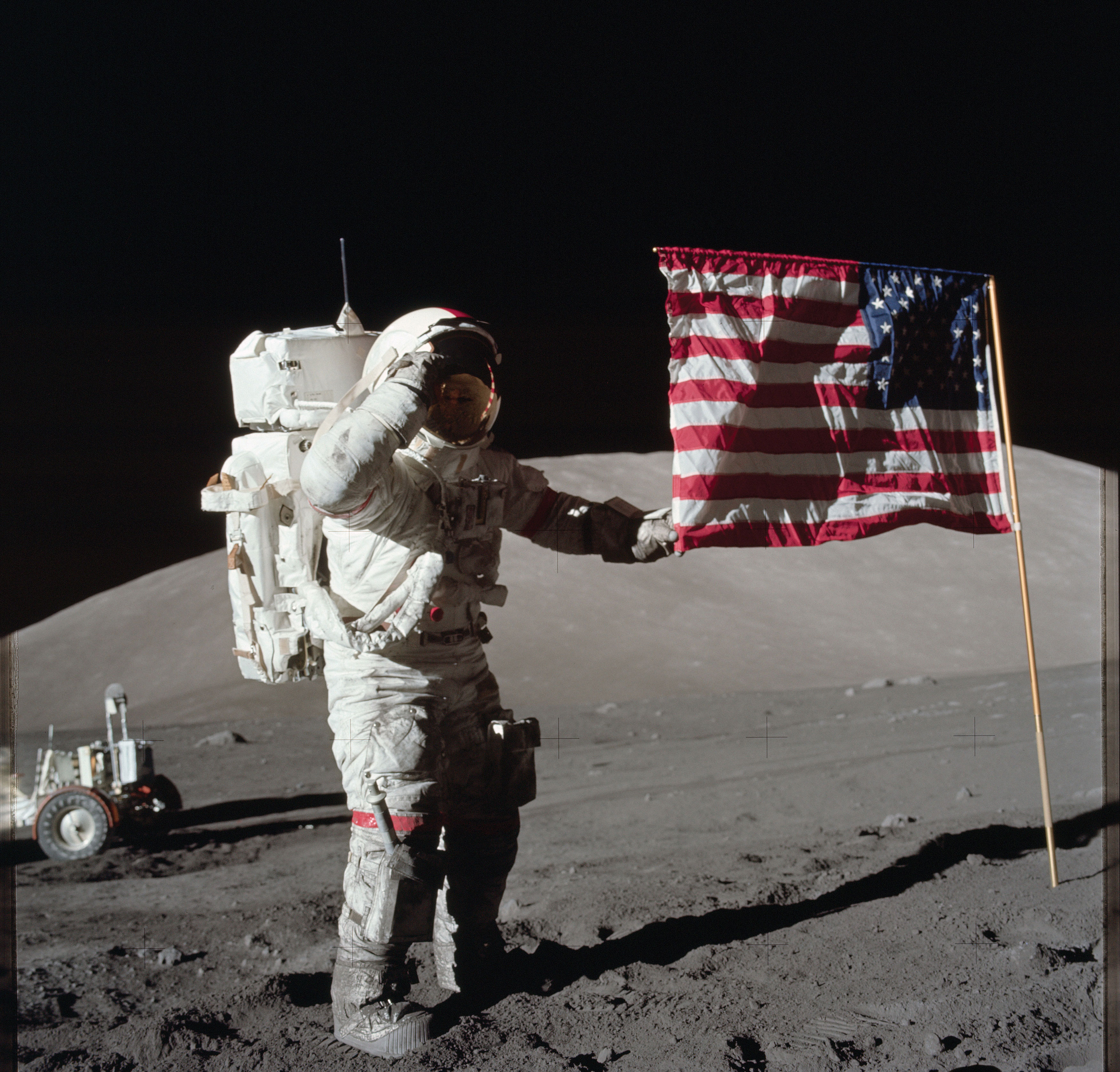
Just as water pressure in a decorative fountain causes the liquid to break up into droplets, this so-called ‘fire fountain’ was composed of an intensely hot spray. In the weak gravity, the droplets arced hundreds or perhaps thousands of feet through the vacuum.
During their flight, they cooled into tiny glass spheres, which rained down on the valley of Taurus-Littrow.” The beads derived their colour from the specific chemical composition of the lava – as indeed did the green beads recovered by Apollo 15. The dark soils of Taurus-Littrow would prove to be chemically identical to the orange stuff, the difference being that if the lava cooled rapidly it formed glass and if it cooled more slowly it produced dark crystals.
In conclusion, wrote Chaikin, both the orange soil and the dark stuff on the valley floor were evidence of volcanism, but the fire fountains had not occurred recently: in fact, they were around three and a half billion years old. The impact some 19 million years ago which created Shorty also excavated the buried materials to the surface ready for an astronaut nicknamed Twinkletoes to sample them.
Only one more period on the Moon’s surface awaited them. On the afternoon of 13 December 1972, a little under seven days since launching from Florida, Cernan and Schmitt were outside for the third time.
Before launch, Schmitt – who had examined almost every aspect of the J-series space suits and their capabilities – had lobbied hard to get a fourth EVA tacked onto the mission, but to no avail: the conservative managers were aware that any emergency might leave them dangerously close to their water and battery reserves.
Cernan, too, was convinced that it could be done, but ultimately bowed to the judgement of programme manager Owen Morris.
The two men drove north past Sherlock Crater, swung right at Turning Point Rock and then across the lower flank of the North Massif. Orbital photographs had shown a large, dark-hued boulder, trailed by a five-hundred-metre furrow down the hillside. As they neared the boulder, Cernan and Schmitt could now see that it had broken into five fragments as it came to rest.
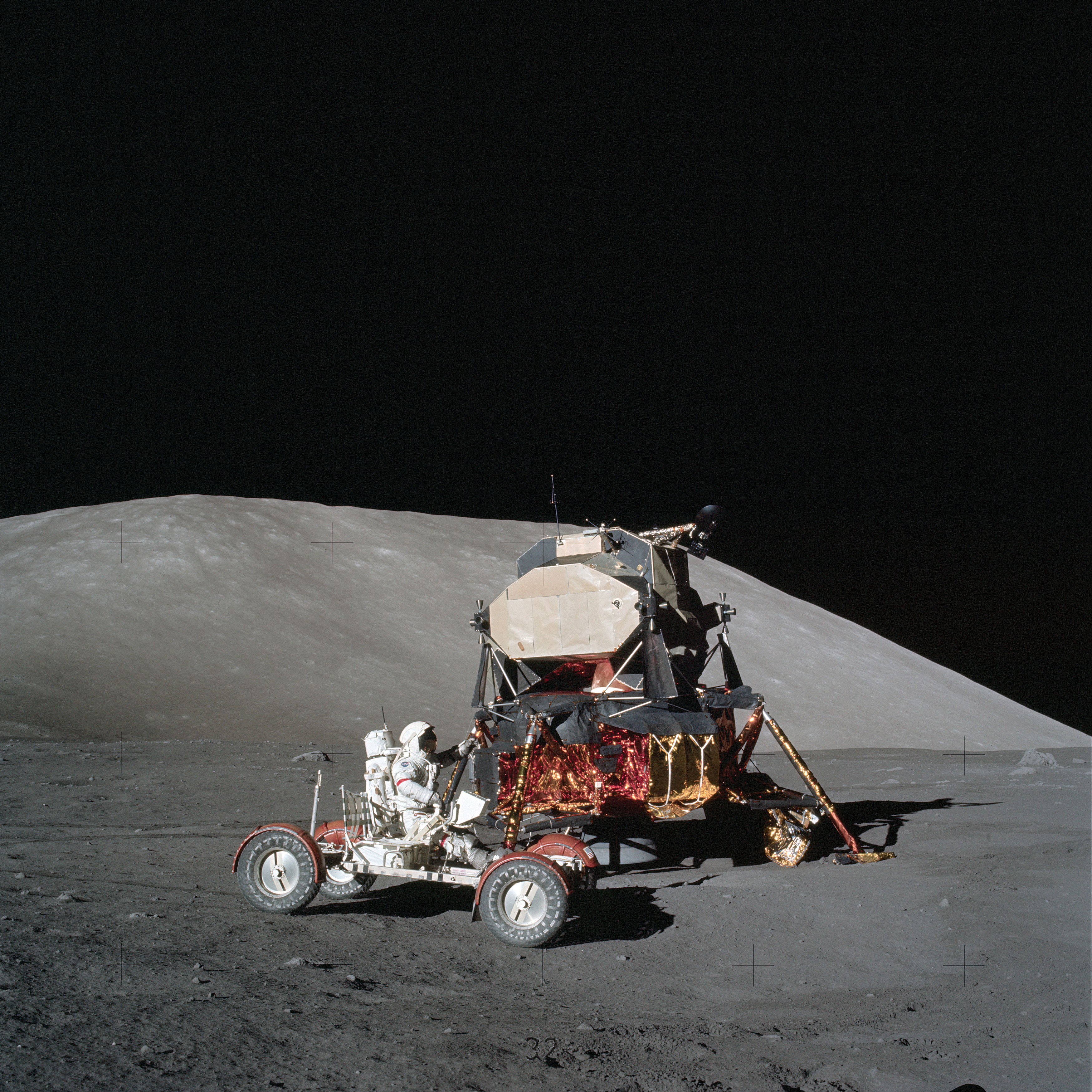
Schmitt was in his element, making a clear and decisive field study of the boulder in an effort to piece together its history, whilst Cernan huffed and puffed upslope to take a series of panoramic images of the geologist at work. One of these pictures is featured on the front cover of this book.
By the time that Cernan and Schmitt had completed their final sampling stop at the Sculptured Hills, they had effectively explored Taurus-Littrow from one end of the valley to the other and with three extravehicular sessions in excess of seven hours apiece, they had easily amassed more time on the surface than any other crew.
They had driven some 18 miles in the rover – whose makeshift fender finally snapped off during the ride back towards Challenger – and their 75 hours on the Moon were drawing inexorably to a close.
Both were exhausted, grimy and sore in their arms and hands, but their suits – those remarkable miniature spacecraft, upon which their lives so depended – had come through with flying colours.
The glory of Apollo was ending and Cernan had known for some time that he would be the last man on the Moon for many years to come.
Such thoughts were clearly on his mind when, shortly after 12:30 am EST on 14 December 1972, he took his final steps on the surface of a world other than that of his birth and heritage. He turned for one last look at the stark landscape – the Sculptured Hills, the North and South Massifs, the thousands of craters, the dark sky and the Earth hanging silently above – and suddenly found the words that he wanted to say.
More than three years earlier, Neil Armstrong’s first words were uttered in triumph; now Cernan’s last words were uttered with undisguised angst.
“Bob,” he radioed to the ever-present Capcom Bob Parker in Mission Control, “this is Gene. As I take these last steps from the surface, back home for some time to come, but we believe not too long into the future, I believe history will record that America’s challenge of today has forged man’s destiny of tomorrow…And as we leave the Moon at Taurus-Littrow, we leave as we came and, God willing, as we shall return, with peace and hope for all mankind. Godspeed the crew of Apollo 17.”
Those resonating words – spoken by a man with vision and passion and conviction and patriotism and childlike excitement for the thrill of adventure and discovery – continue to haunt us, for 40 years later we are still waiting.
Cernan believed history would record that America’s achievement had forged man’s future destiny, and in a sense, it did, and it continues to drive our species forward as an example of our ingenuity and ability to overcome the most immense obstacles.
However, the fact remains that the most promising endeavour in our history, whilst expensive, was abandoned in its prime.
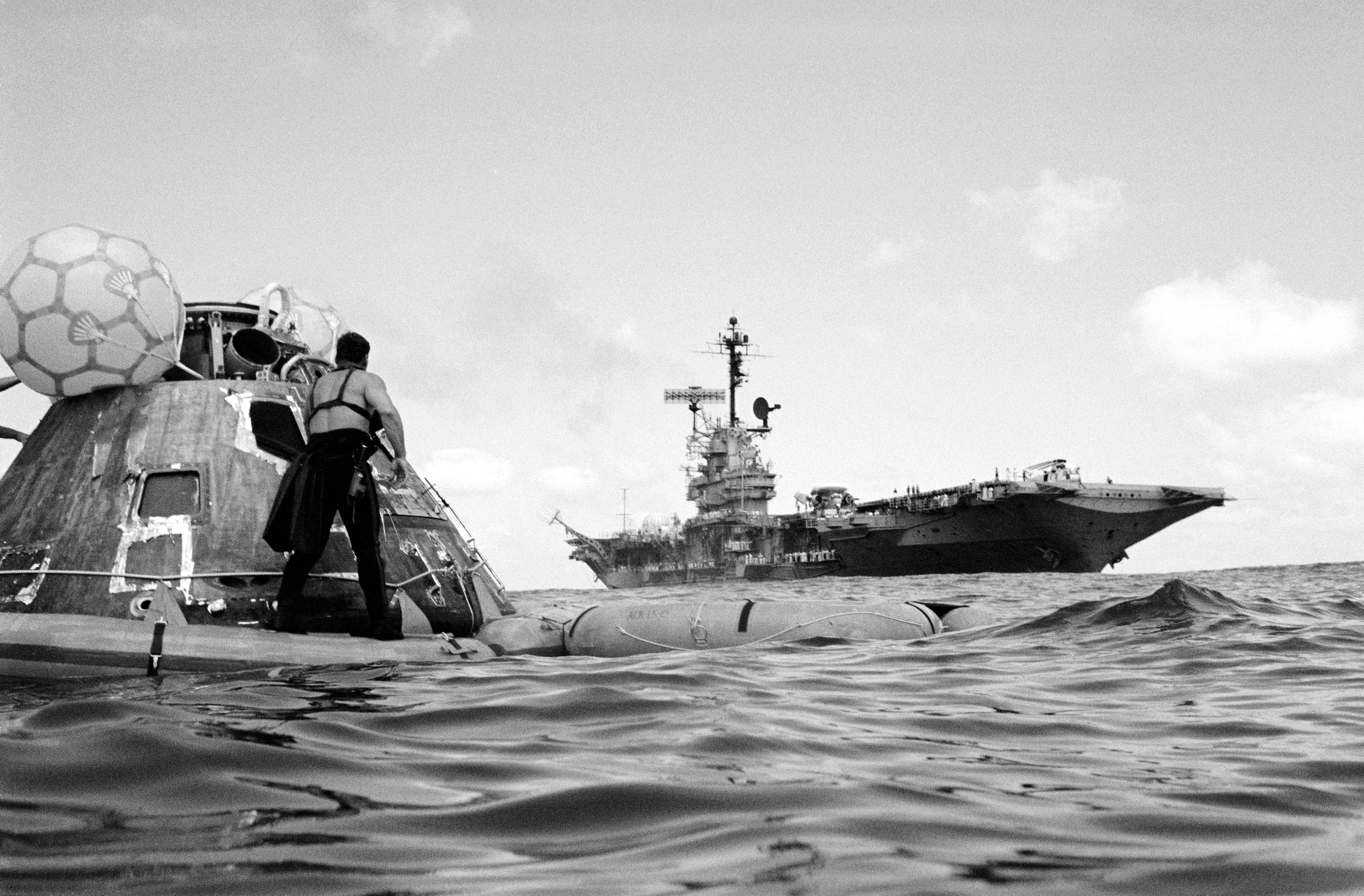
As well as recording the greatest example of risk-and-reward ever undertaken, history also recorded our species losing its nerve.
“History,” Apollo 17 backup crewman Stu Roosa once said, “will not be kind to us, because we were stupid.”
For now, we have only the images and the newsreel film and the memories to remind us of a golden age before many of us – including this author – were even born.
And we have Gene Cernan’s priceless last words.
God willing…
We shall return…
Someday.
Authored by Ben Evans, this article originally appeared online at AmericaSpace.org. Many of the mission photos have been provided by Retro Space Images.

